RELG 433 - Biblical Archaeology
Brief Biographies of some archaeologists
in roughly chronological order
Images in the text are linked to larger photos - click on them to see the larger pictures.
Hover the mouse over the images to see their captions and copyright credits.
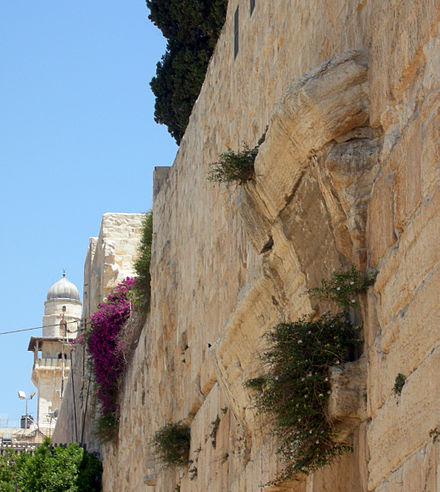 Howard Robinson (1794-1863), an American biblical scholar,traveled in Palestine in 1836
Howard Robinson (1794-1863), an American biblical scholar,traveled in Palestine in 1836
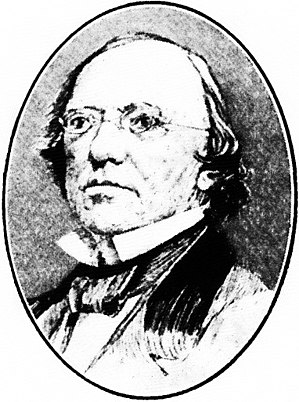 and identified places mentioned in the Bible. He discovered the Siloam tunnel in Jerusalem,
and "Robinson's Arch" - the remains of an arched bridge into the Temple complex of Jerusalem. He described what he saw in his book Biblical Researches in Palestine in 1841. This aroused interest in Palestine as an area for study. Robinson is often described as "one of the founders of Biblical Archaeology"
and identified places mentioned in the Bible. He discovered the Siloam tunnel in Jerusalem,
and "Robinson's Arch" - the remains of an arched bridge into the Temple complex of Jerusalem. He described what he saw in his book Biblical Researches in Palestine in 1841. This aroused interest in Palestine as an area for study. Robinson is often described as "one of the founders of Biblical Archaeology"
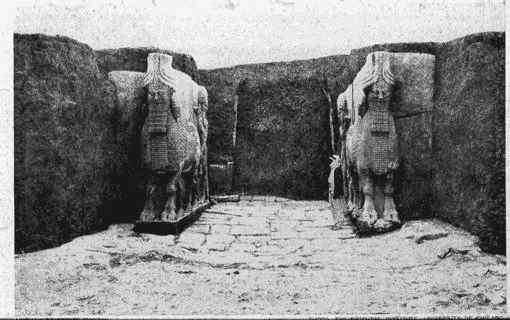 Paul Emile Botta (1802-1870) was sent as the French Consul in Mosul, up the Tigris from Baghdad, in 1842. Mosul was near some ruins at Kuyunjik that were thought to be those of Nineveh,
Paul Emile Botta (1802-1870) was sent as the French Consul in Mosul, up the Tigris from Baghdad, in 1842. Mosul was near some ruins at Kuyunjik that were thought to be those of Nineveh,
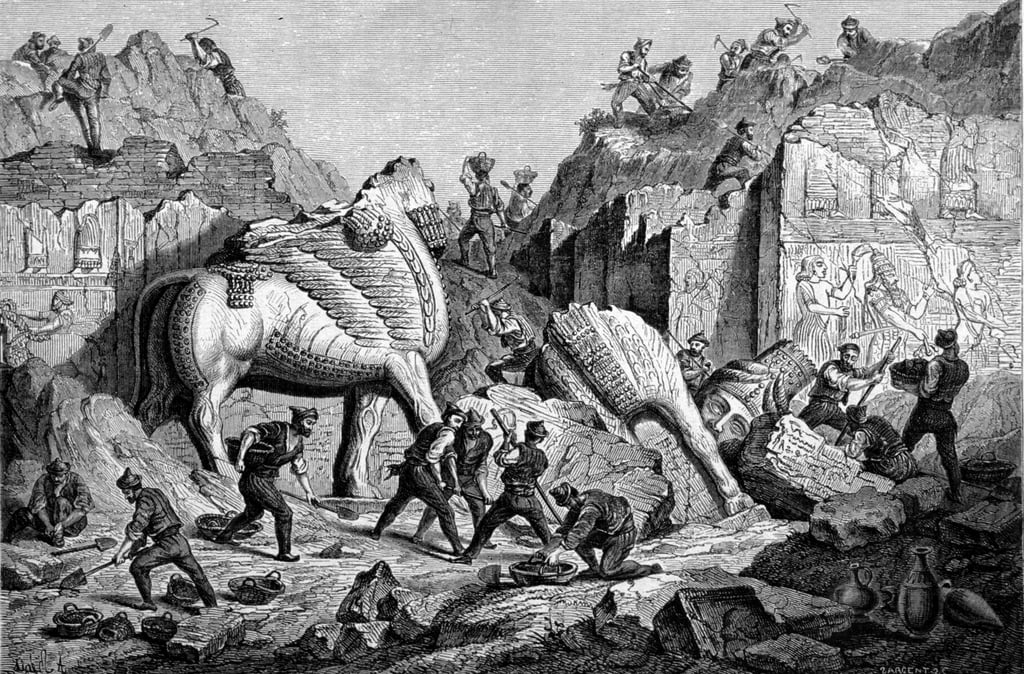 so Botta started excavation there, but did not find much. In 1843 he dug at Dur-Sharrukin (Khorsabad) and discovered the Palace of Sargon II of Assyria, thinking that he had found Nineveh. Treasures from 3 temples, 1 ziggurat, 209 chambers of the palace - 1855 objects, and records - were crated and put on 5 boats. They were attacked, capsized, and all were lost. All that we have are a small earlier collection and 2 winged bulls. A change in the French government resulted in Botta being re-assigned to another consulate, and other archaeologists, including Austen Layard, continued the work at Khorsabad.
so Botta started excavation there, but did not find much. In 1843 he dug at Dur-Sharrukin (Khorsabad) and discovered the Palace of Sargon II of Assyria, thinking that he had found Nineveh. Treasures from 3 temples, 1 ziggurat, 209 chambers of the palace - 1855 objects, and records - were crated and put on 5 boats. They were attacked, capsized, and all were lost. All that we have are a small earlier collection and 2 winged bulls. A change in the French government resulted in Botta being re-assigned to another consulate, and other archaeologists, including Austen Layard, continued the work at Khorsabad.
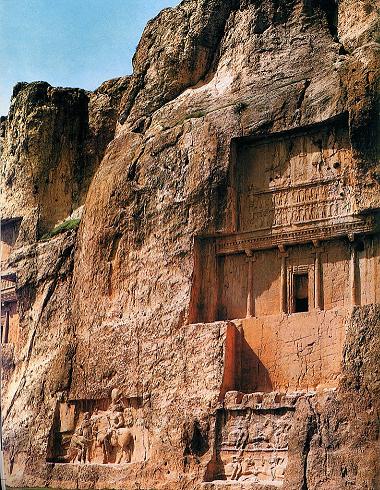
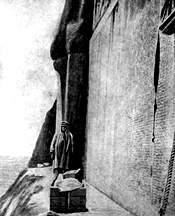 Henry Creswicke Rawlinson (1810-1895) was a British army officer, member of Parliament, and orientalist. Because he was proficient in the Persian language
Henry Creswicke Rawlinson (1810-1895) was a British army officer, member of Parliament, and orientalist. Because he was proficient in the Persian language
 he was part of a company of British army officers sent to help the Shah of Persia reorganize the Persian army. While there, he began to study ancient cuneiform inscriptions, and in 1836 he visited the rocks at Behistun in Mesopotamia, where tombs had been cut into the cliff face. Some of the inscriptions were trilingual - in Old Persian, Elamite, and Babylonian, and dated to the time of Darius the Great (522 BC-486 BC). Rawlinson climbed the cliff face, transcribed the inscriptions, worked on their interpretation, and deciphered the cuneiform writing.
he was part of a company of British army officers sent to help the Shah of Persia reorganize the Persian army. While there, he began to study ancient cuneiform inscriptions, and in 1836 he visited the rocks at Behistun in Mesopotamia, where tombs had been cut into the cliff face. Some of the inscriptions were trilingual - in Old Persian, Elamite, and Babylonian, and dated to the time of Darius the Great (522 BC-486 BC). Rawlinson climbed the cliff face, transcribed the inscriptions, worked on their interpretation, and deciphered the cuneiform writing.
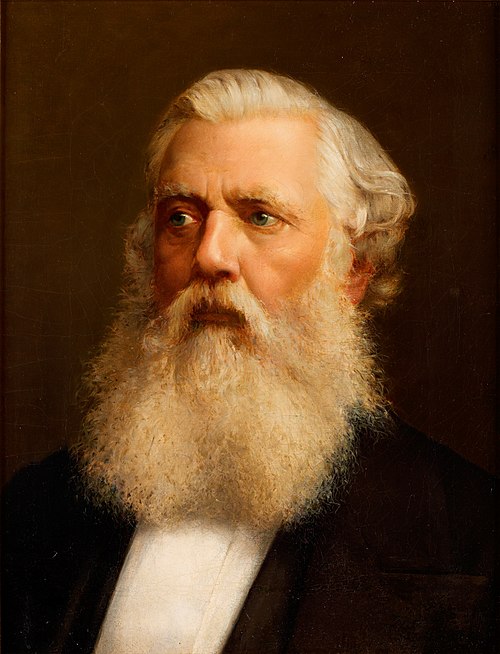 Austen Henry Layard (1817-1894). Layard's father was in the British civil service, and Henry was born in France, and spent much of his childhood in various European countries. In 1839 Layard set out to ride from Europe to India, intending to join the civil service in Sri Lanka. However, when he reached Persia he was so intrigued by the mounds on the banks of the Tigris that he returned to Constantinople and contacted the British Ambassador there. He was employed on various missions in the Middle East, and was eventually given permission to explore the ruins near Mosul. He arrived in Mosul in 1845 and started digging at a series of mounds 17 miles downstream. In one month, Layard discovered three Assyrian palaces, all decorated with sculptures. This site turned out to be Nimrud, the Biblical city known as Caleh. With very limited funds, and having to improvise everything, supervising as many as 600 men, Austen Henry Layard uncovered a hitherto virtually unknown civilization almost single-handed. He excavated at Nimrud first, then moved upstream to the ancient city opposite Mosul. Unlike Botta, who had dug there earlier, Layard dug in the right place, and found the royal palace of King Ashurbanipal in 1850. Layard piled the artefacts into baskets and shipped them home. Some of the statues had to be sawn in pieces to be able to move them and get them on boats to sail down the Tigris. Several priceless pieces were lost when one of the boats capsized and sank. On arrival at the British Museum the crates were put into storage - it was about 25 years before they were sorted and deciphered. They are now on display in the Assyrian Galleries of the British Museum. Layard published his discoveries in several illustrated volumes - they aroused great interest in the archaeology of the Middle East.
Austen Henry Layard (1817-1894). Layard's father was in the British civil service, and Henry was born in France, and spent much of his childhood in various European countries. In 1839 Layard set out to ride from Europe to India, intending to join the civil service in Sri Lanka. However, when he reached Persia he was so intrigued by the mounds on the banks of the Tigris that he returned to Constantinople and contacted the British Ambassador there. He was employed on various missions in the Middle East, and was eventually given permission to explore the ruins near Mosul. He arrived in Mosul in 1845 and started digging at a series of mounds 17 miles downstream. In one month, Layard discovered three Assyrian palaces, all decorated with sculptures. This site turned out to be Nimrud, the Biblical city known as Caleh. With very limited funds, and having to improvise everything, supervising as many as 600 men, Austen Henry Layard uncovered a hitherto virtually unknown civilization almost single-handed. He excavated at Nimrud first, then moved upstream to the ancient city opposite Mosul. Unlike Botta, who had dug there earlier, Layard dug in the right place, and found the royal palace of King Ashurbanipal in 1850. Layard piled the artefacts into baskets and shipped them home. Some of the statues had to be sawn in pieces to be able to move them and get them on boats to sail down the Tigris. Several priceless pieces were lost when one of the boats capsized and sank. On arrival at the British Museum the crates were put into storage - it was about 25 years before they were sorted and deciphered. They are now on display in the Assyrian Galleries of the British Museum. Layard published his discoveries in several illustrated volumes - they aroused great interest in the archaeology of the Middle East.
In his later years, Layard became a politician, and was elected as a Member of Parliament. Then he became a diplomat, and was appointed British Ambassador to the Ottoman Empire in 1877.
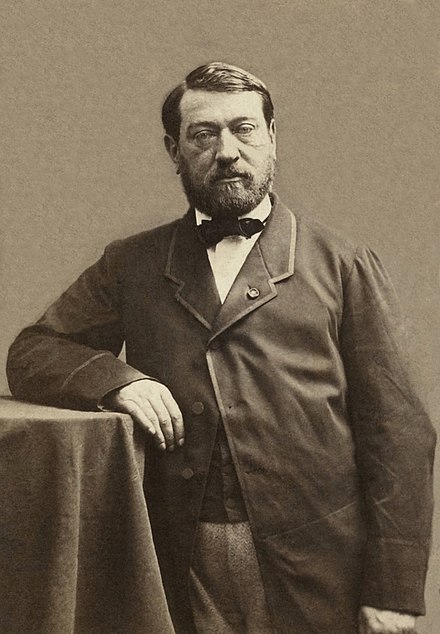 Auguste Mariette (1821-1881) was a French linguist who was sent to Egypt by the Louvre in Paris, to look for ancient manuscripts in 1850. He did not have much success, so started to visit some of the monuments in Egypt. He made friends with a local Bedouin tribe who led him to Saqqara, where he noticed a half-buried statue of a sphinx. In 1851 he started to dig at Saqqara and uncovered the avenue of sphinxes, a tomb complex with Apis Bulls, the tomb of one of the sons of Rameses II, and thousands of other artifacts. Half of the artifacts were sent to the Louvre, and half were retained by Egypt.
Auguste Mariette (1821-1881) was a French linguist who was sent to Egypt by the Louvre in Paris, to look for ancient manuscripts in 1850. He did not have much success, so started to visit some of the monuments in Egypt. He made friends with a local Bedouin tribe who led him to Saqqara, where he noticed a half-buried statue of a sphinx. In 1851 he started to dig at Saqqara and uncovered the avenue of sphinxes, a tomb complex with Apis Bulls, the tomb of one of the sons of Rameses II, and thousands of other artifacts. Half of the artifacts were sent to the Louvre, and half were retained by Egypt.
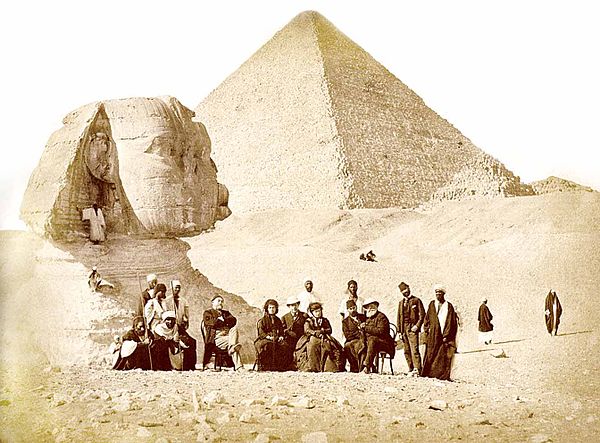 In 1858 the Egyptian government appointed Mariette as Conservator of Egyptian Monuments and director-general of the newly-created Egyptian Antiquities Service, and he moved to Cairo, from where he supervised the opening of new dig sites and the conservation of existing sites. In 1863 he opened the Egyptian Museum in Cairo, which today is one of the great archaeological museums in the world, housing the treasures from the tomb of Tutankhamun, and the mummy of Rameses II. He started to use stratigraphic methods of excavation, and the photography of artefacts before excavating them. He cleared the sands away from the Great Sphinx (at Giza, on the outskirts of Cairo) and discovered the Temple of the Sphinx beside it. Excavations included those at Karnak, Memphis, Saqqara, Abydos, Thebes, Medinet-Habu, and Deir el-Bahri.
In 1858 the Egyptian government appointed Mariette as Conservator of Egyptian Monuments and director-general of the newly-created Egyptian Antiquities Service, and he moved to Cairo, from where he supervised the opening of new dig sites and the conservation of existing sites. In 1863 he opened the Egyptian Museum in Cairo, which today is one of the great archaeological museums in the world, housing the treasures from the tomb of Tutankhamun, and the mummy of Rameses II. He started to use stratigraphic methods of excavation, and the photography of artefacts before excavating them. He cleared the sands away from the Great Sphinx (at Giza, on the outskirts of Cairo) and discovered the Temple of the Sphinx beside it. Excavations included those at Karnak, Memphis, Saqqara, Abydos, Thebes, Medinet-Habu, and Deir el-Bahri.
Heinrich Schliemann (1822-1890), was a German American businessman who was fascinated by the story of Troy.
Go here for the separate webpage on the archaeology of prehistoric Greece and the Aegean.
 Amelia Edwards (1831-1892) was an English novelist who traveled up the Nile on a sight-seeing expedition in 1873-1874. She was shocked to see the destruction caused by wholesale haphazard excavation. She spent the rest of her life writing and lecturing about the destruction of Ancient Egypt. In 1877 she published a travelogue with her own illustrations, A Thousand Miles up the Nile, and in 1882 she co-founded the Egypt Exploration Fund with Reginald Stuart Poole of the British Museum. She died in 1892, leaving her collection of Egyptian antiquities, her library, and finances to endow a Chair of Egyptology at University College, London.
Amelia Edwards (1831-1892) was an English novelist who traveled up the Nile on a sight-seeing expedition in 1873-1874. She was shocked to see the destruction caused by wholesale haphazard excavation. She spent the rest of her life writing and lecturing about the destruction of Ancient Egypt. In 1877 she published a travelogue with her own illustrations, A Thousand Miles up the Nile, and in 1882 she co-founded the Egypt Exploration Fund with Reginald Stuart Poole of the British Museum. She died in 1892, leaving her collection of Egyptian antiquities, her library, and finances to endow a Chair of Egyptology at University College, London.
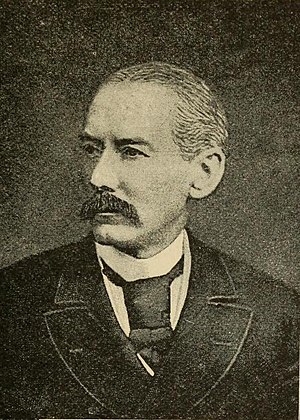 Charles William Wilson (1836-1905) was a British army officer who was sent to Jerusalem to do an Ordnance Survey,
Charles William Wilson (1836-1905) was a British army officer who was sent to Jerusalem to do an Ordnance Survey,
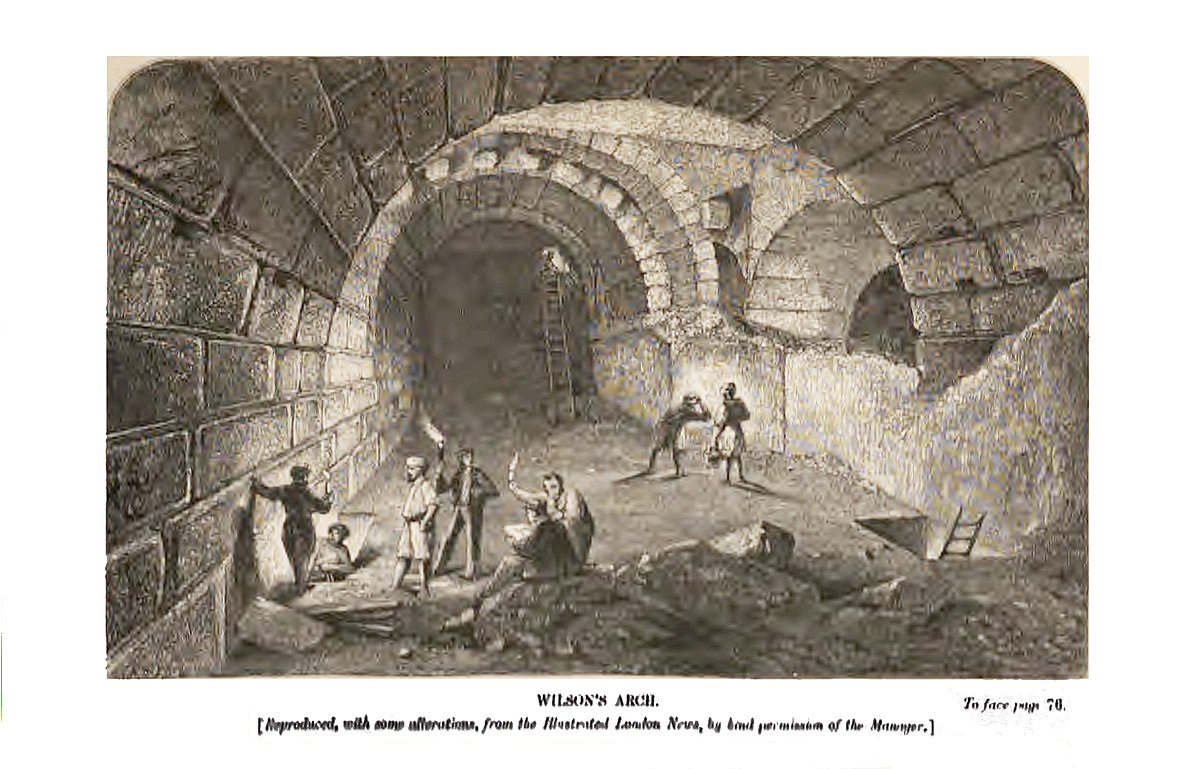 and while there he conducted archaeological studies of the Temple Mount.
and while there he conducted archaeological studies of the Temple Mount.
 He started the survey of Jerusalem in 1864, expanded his work to a survey of Palestine in 1867, and then to the Sinai in 1868.
He started the survey of Jerusalem in 1864, expanded his work to a survey of Palestine in 1867, and then to the Sinai in 1868.
In 1867 Wilson conducted one of the first excavations at the Temple Mount. He identified the remains of a what had been a bridge leading into the courts of the Second Temple. This is known as "Wilson's Arch", and now leads from the modern Prayer Plaza at the Western Wall, to a passage by the walls which is used as a synagogue.
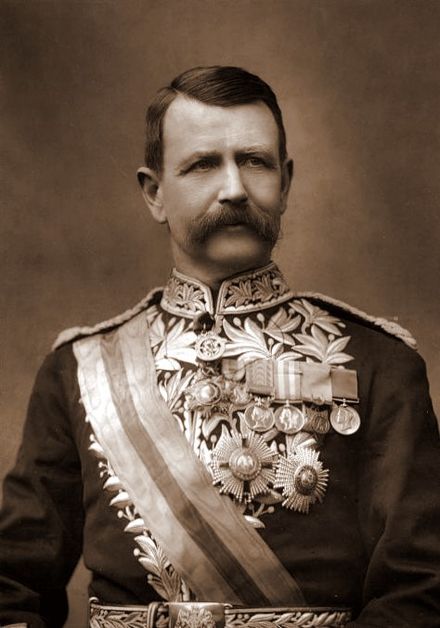 Charles Warren (1840-1927) was a British soldier who eventuality became a General. Early in his career Warren was an officer working as a surveyor with the Royal Engineers. In 1867 the Palestine Exploration Fund asked Warren to conduct a "reconnaissance" in Syria and the Holy Land, to identify Biblical sites for excavation. Warren not only conducted the first systematic survey of Biblical sites in the Holy Land, but also started excavation at the Temple Mount in Jerusalem. He discovered the system of water tunnels under Jerusalem, including "Warren's Shaft" - a long nearly-vertical tunnel which had been dug and used by the early inhabitants of the city to fetch water from the Gihon stream.
Charles Warren (1840-1927) was a British soldier who eventuality became a General. Early in his career Warren was an officer working as a surveyor with the Royal Engineers. In 1867 the Palestine Exploration Fund asked Warren to conduct a "reconnaissance" in Syria and the Holy Land, to identify Biblical sites for excavation. Warren not only conducted the first systematic survey of Biblical sites in the Holy Land, but also started excavation at the Temple Mount in Jerusalem. He discovered the system of water tunnels under Jerusalem, including "Warren's Shaft" - a long nearly-vertical tunnel which had been dug and used by the early inhabitants of the city to fetch water from the Gihon stream.
Sir Arthur John Evans (1851-1941) excavated on the island of Crete during 1900-1935, mainly at Knossos, and uncovered the remains of the previously unknown Minoan civilization.
Go here for the separate webpage on the archaeology of prehistoric Greece and the Aegean.
Sir William Matthew Flinders Petrie (1853-1942) was home-schooled, and was taught surveying by his father.
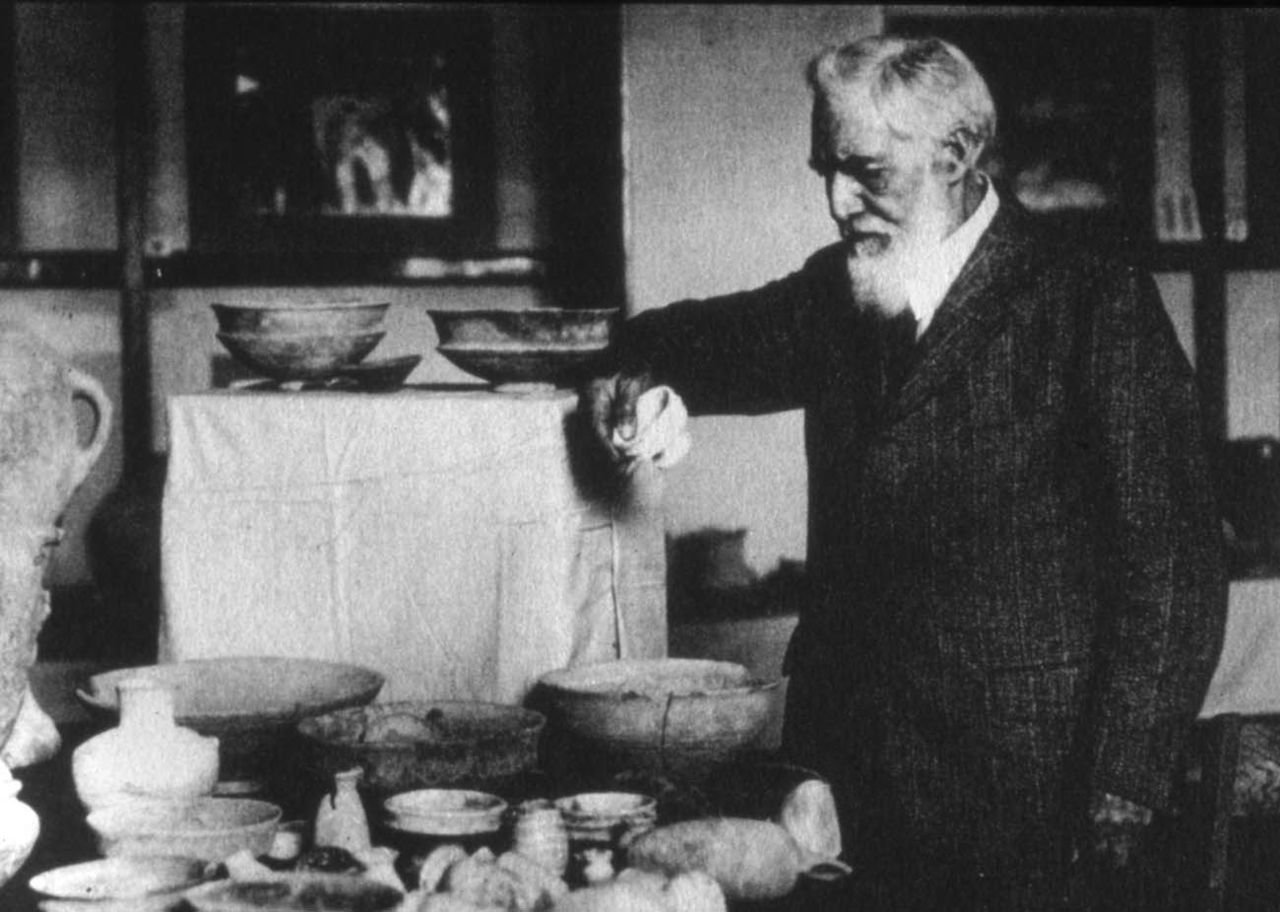 Petrie was interested in archaeology from his childhood, and started his career by surveying sites in Britain, including Stonehenge.
Petrie was interested in archaeology from his childhood, and started his career by surveying sites in Britain, including Stonehenge.
"I was horrified at hearing of the rough shovelling out of the contents and protested that the earth ought to be pared away inch by inch to see all that was in it, and how it lay. . . . All I have done since was there to begin with . . . I was already in archaeology by nature" - Sir William Flinders Petrie, describing how he felt at eight years of age, on hearing a description of the excavation of a Roman villa. (Seventy Years in Archaeology, Flinders Petrie, 1932)
In 1880 Petrie traveled to Egypt to investigate the pyramids at Giza first-hand, and published a survey of Giza and the pyramids which is still valid today. Again, he was horrified at the destruction of monuments and mummies, and determined to do all he could to salvage what remained. On his return to England he met Amelia Edwards, who was influential in getting University College, London, to offer him work as an excavator in Egypt, and later to appoint him as the Chair of Egyptology which she endowed.
In 1884 Petrie arrived in Egypt to start his archaeological work at various sites.
In 1890 he traveled to Palestine to excavate Tell el-Hesi - this was the first scientific excavation of an archaeological site in the Holy Land.
In 1891 he excavated at Tell el-Amarna (Akhnaten's capital city) in Egypt.
In 1894 Petrie founded the Egyptian Research Account, which eventually (in 1905) became the British School of Archaeology, in Egypt
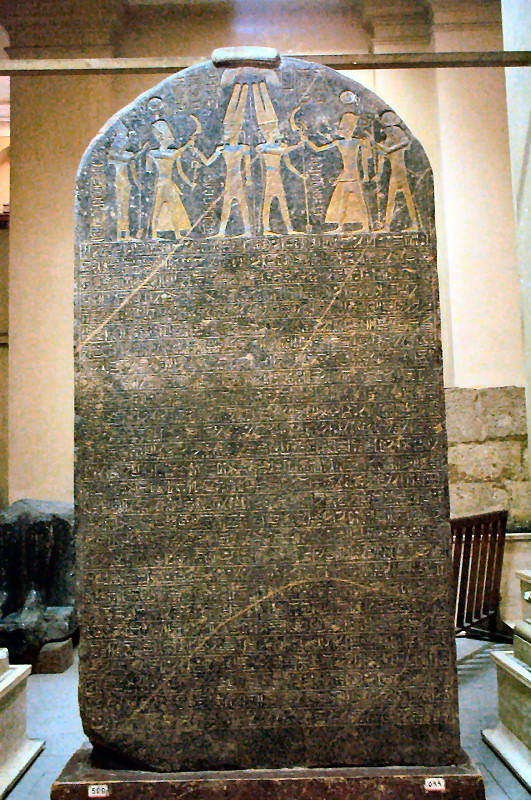 In 1896, excavating one of the mortuary temples at Luxor, Petrie made one of the great discoveries of Biblical archaeology - the Stele of Merneptah. The stele commemorates Merneptah's campaign in Canaan, and mentions Israel for the first and only time in Egyptian sources.
In 1896, excavating one of the mortuary temples at Luxor, Petrie made one of the great discoveries of Biblical archaeology - the Stele of Merneptah. The stele commemorates Merneptah's campaign in Canaan, and mentions Israel for the first and only time in Egyptian sources.
In 1926 Petrie's interests turned to the Holy Land, though he did continue with some excavations in Egypt.
During 1927-1938 Petrie excavated sites in Palestine, sponsored by the American School of Research.
In 1933 he retired from his Chair at University College, and moved to Jerusalem, where he lived until his death in 1942.
Petrie was responsible for developing the methodology of archaeology. He was particularly innovative in the interpretation of stratified deposits, organizing chronological series of undecorated pottery and demonstrating how ceramics from Egypt could be used to establish the age of archaeological strata outside Egypt - a technique known as cross-dating. He trained many young archaeologists, including Howard Carter.
As a point of interest, some of Petrie's relatives moved to the USA and live in New Mexico. One of the family became a student at ENMU, and on taking this REL 433 course remarked, "I knew he had been an archaeologist, but I didn't know he was famous."
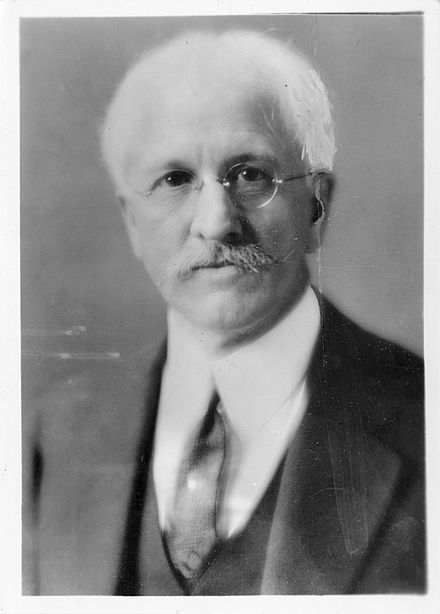 James Henry Breasted (1865-1935) was an American archaeologist who specialized in Egyptology. After studying at several American universities he moved to Germany to study the ancient Egyptian language. In 1894 he completed his doctorate on Egyptology at the University of Berlin, and then joined the faculty of the University of Chicago, where he became director of the Oriental Museum in 1901.
James Henry Breasted (1865-1935) was an American archaeologist who specialized in Egyptology. After studying at several American universities he moved to Germany to study the ancient Egyptian language. In 1894 he completed his doctorate on Egyptology at the University of Berlin, and then joined the faculty of the University of Chicago, where he became director of the Oriental Museum in 1901.
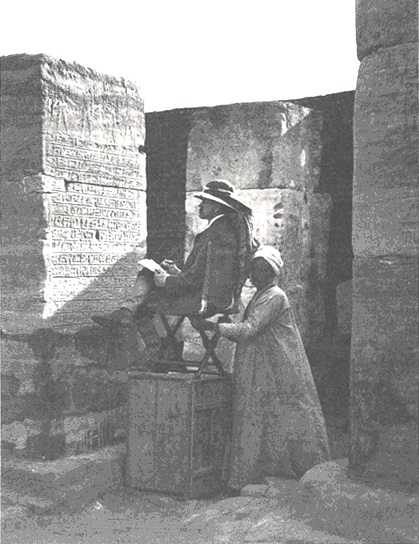 He did fieldwork in Egypt for nine years, from 1899 to 1908, and published many articles and a History of Egypt which aroused public interest in Egyptology.
He did fieldwork in Egypt for nine years, from 1899 to 1908, and published many articles and a History of Egypt which aroused public interest in Egyptology.
In 1905 he became the first Professor of Egyptology in the USA, when the University of Chicago promoted him to full professor.
In 1919 he founded the Oriental Institute of the University of Chicago, as "a laboratory for the study of the rise and development of civilization", which has become one of the leading institutions for the study of ancient civilizations.
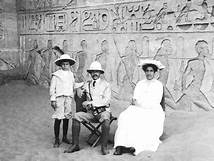 One of his aims was to select sites for future excavations, so he took a small group of his students on a field trip to Egypt, India, Mesopotamia, and the Levant. During this trip he met some of the British archaeologists who were working in the field - Gertrude Bell, Howard Carter, and Lord Carnarvon. He also met some of the British and Arab soldiers and politicians, including Lord Allenby (British High Commissioner for Egypt) and the future King Faisal of Jordan, and was entrusted with messages from Lord Allenby to the British Prime Minister about the political and military conditions in the region. On this trip and on subsequent visits Breasted acquired articles for the collections at the Oriental Institute.
One of his aims was to select sites for future excavations, so he took a small group of his students on a field trip to Egypt, India, Mesopotamia, and the Levant. During this trip he met some of the British archaeologists who were working in the field - Gertrude Bell, Howard Carter, and Lord Carnarvon. He also met some of the British and Arab soldiers and politicians, including Lord Allenby (British High Commissioner for Egypt) and the future King Faisal of Jordan, and was entrusted with messages from Lord Allenby to the British Prime Minister about the political and military conditions in the region. On this trip and on subsequent visits Breasted acquired articles for the collections at the Oriental Institute.
Breasted supported Howard Carter's excavation of the Tomb of Tutankhamun, and was present when the tomb was opened.
Breasted introduced the term "the Fertile Crescent" for the area Mesopotamia-Syria-Lebanon-Palestine-Israel, the homeland of so many early civilizations.
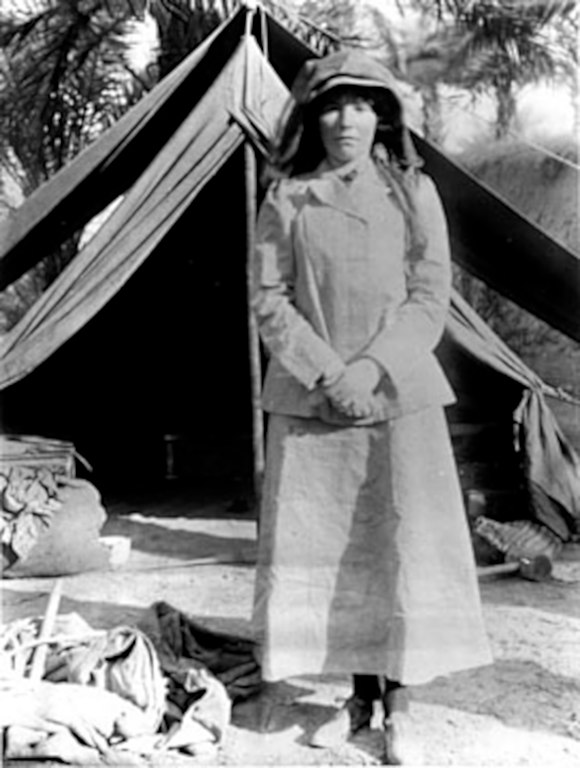 Gertrude Bell (1868-1926) was a British traveler, writer, political administrator, and archaeologist. Her family was deeply involved in politics - her grandfather was a member of Parliament, and her father was an industrialist who served in various government offices. She studied at London and then Oxford, although women were awarded certificates rather than academic degrees at that time. (Oxford University did not award degrees to women until 1920).
Gertrude Bell (1868-1926) was a British traveler, writer, political administrator, and archaeologist. Her family was deeply involved in politics - her grandfather was a member of Parliament, and her father was an industrialist who served in various government offices. She studied at London and then Oxford, although women were awarded certificates rather than academic degrees at that time. (Oxford University did not award degrees to women until 1920).
Bell's uncle was the British minister in Tehran, so in 1892 she traveled there to visit him, then traveled around the world, mountaineering, exploring archaeological sites, and learning languages. She was fluent in Persian, Arabic, French, and German, and also spoke Italian and Turkish. For the next twenty years she traveled widely, exploring and mapping the Middle East, and publishing several books about her travels.
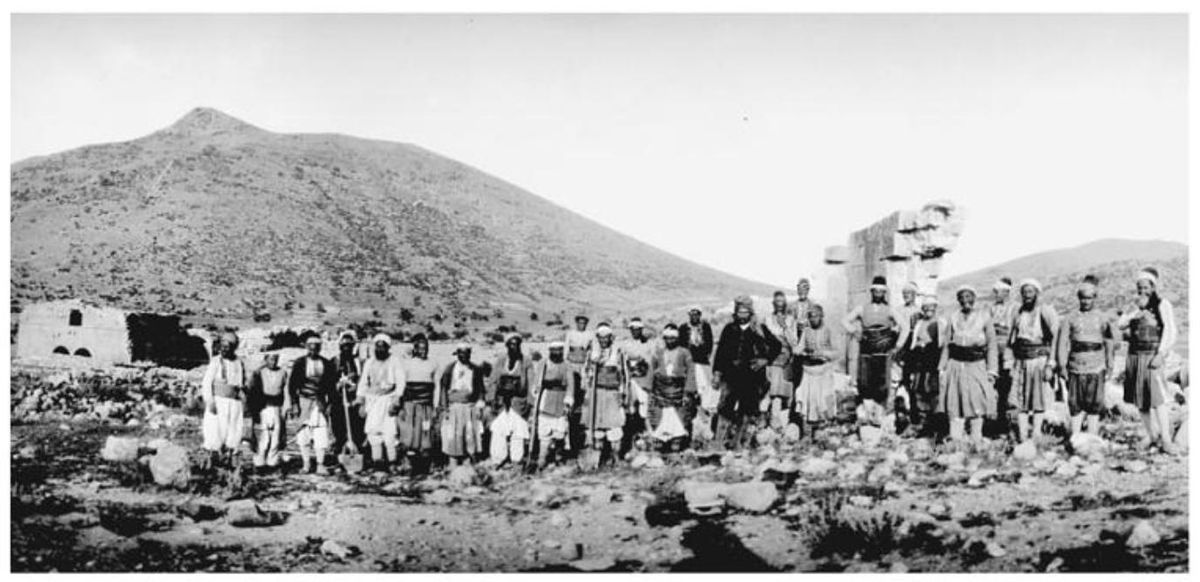 In 1907 she joined in an archaeological dig at Binbirkilise in Syria and uncovered the remains of the old city. Then in 1909 she returned to Mesopotamia, visiting Babylon and Carchemish, where she met T. E. Lawrence.
In 1907 she joined in an archaeological dig at Binbirkilise in Syria and uncovered the remains of the old city. Then in 1909 she returned to Mesopotamia, visiting Babylon and Carchemish, where she met T. E. Lawrence.
In 1924 she invited other archaeologists to start excavations at Nuzi in Iraq, where a library of burnt clay tablets was found. The Nuzi Tablets are inscribed with texts which help to illustrate what life was like at the time of the Patriarchs.
Because of her experience of the Middle East, during WW I the British Intelligence Service asked her to help lead troops through the deserts. Her acquaintance with tribal leaders and their wives gave her a unique position of influence for British foreign relations in the Middle East - she was able to give information for British foreign policy, and helped to set up the State of Iraq when the Ottoman Empire disintegrated. She represented the British government to the Arab nations and, together with T. E. Lawrence, helped establish Hashemite dynasties in Jordan and Iraq. She was part of the committee which founded what has become the National Library of Iraq. She believed that archaeological treasures should be kept in the countries in which they were found, rather than taken to foreign museums, and started the collections which were the foundation of the Iraqi Museum.
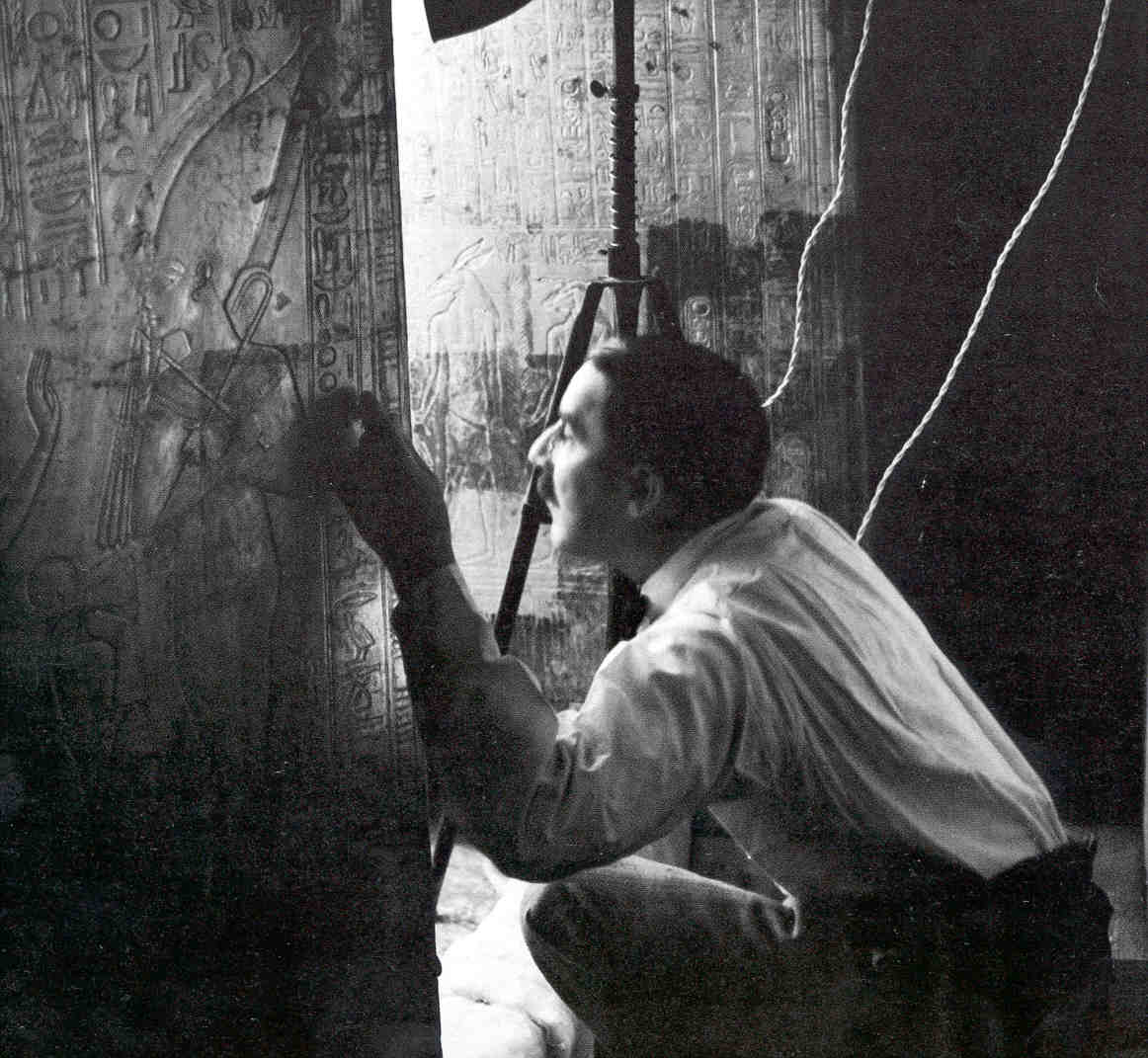 Howard Carter (1874-1939) did not receive an academic education, but showed artistic skills and an interest in Egyptian artefacts. At the age of 17 he was employed by the Egyptian Exploration Fund to help with the excavation and recording of Egyptian tombs at Beni Hassan. He showed such skill in copying the tomb decorations that he was sent to train as an archaeologist for a season with Flinders Petrie at Amarna. During 1894-1899 he worked at the mortuary temple of Queen Hatshepsut at Deir el-Bahari. In 1899 the Egyptian Antiquities Service (EAS) appointed Carter to the position of Inspector of Monuments for Upper Egypt, so he moved to Luxor to oversee other archaeologists at Thebes and the Valley of the Kings. However, Carter evidently had a temper, and did not work well within a bureaucracy, so he resigned from that position in 1905. He was unemployed for several years, supporting himself by selling his paintings to tourists.
Howard Carter (1874-1939) did not receive an academic education, but showed artistic skills and an interest in Egyptian artefacts. At the age of 17 he was employed by the Egyptian Exploration Fund to help with the excavation and recording of Egyptian tombs at Beni Hassan. He showed such skill in copying the tomb decorations that he was sent to train as an archaeologist for a season with Flinders Petrie at Amarna. During 1894-1899 he worked at the mortuary temple of Queen Hatshepsut at Deir el-Bahari. In 1899 the Egyptian Antiquities Service (EAS) appointed Carter to the position of Inspector of Monuments for Upper Egypt, so he moved to Luxor to oversee other archaeologists at Thebes and the Valley of the Kings. However, Carter evidently had a temper, and did not work well within a bureaucracy, so he resigned from that position in 1905. He was unemployed for several years, supporting himself by selling his paintings to tourists.
In 1907 Lord Carnarvon, who had an interest in Egyptology, was interested in excavating some Egyptian tombs at Deir el-Bahri, and the head of the EAS suggested that he employ Howard Carter to oversee the work. For the next sixteen years Carter and Lord Carnarvon worked together in Egypt. However, by 1922 Lord Carnarvon was becoming despondent at the lack of great discoveries, and was considering stopping his funding for the work. Carter persuaded Carnarvon to pay for one more season in the Valley of the Kings. During that season one of the boys helping at the dig tripped over a stone which turned out to be the top of a flight of steps cut into the rock. Carter had the stairway excavated, and found the door to a previously undiscovered tomb, which turned out to be the tomb of Tutankhamun, a young pharaoh of Egypt who died as a teenager. Other tombs of pharaohs had been pillaged by tomb-robbers in antiquity. The tomb of Tutankhamun was the first tomb of an Egyptian pharaoh to be discovered with all its contents still in place. Carter called in other archaeologists, from the Metropolitan Museum and from the Egyptian government, to help with the work of excavating the tomb, which contained over 5,000 items, including the coffin of the young king.
The discovery was sensational, and was publicized world-wide, and aroused an interest in Egyptology and archaeology in the general public.
Lord Carnarvon died of blood-poisoning in 1923, but Lady Carnarvon continued to pay for the work of excavation. For the next ten years Carter excavated the tomb meticulously, keeping records of each step. The finds are usually kept on display in the Cairo Museum, unless they are on loan to other Museums around the world.
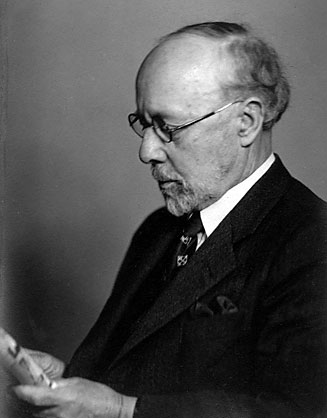 John Garstang (1876-1956) was a British archaeologist who was one of the first to emphasize the need to keep detailed records and photographs of excavations. As an undergraduate, he excavated Roman sites in Britain. When he graduated in 1899 he joined a team led by Flinders Petrie in at Abydos in Egypt, and in 1902 was experienced enough to lead his own archaeological excavation. In 1902 he was appointed to a position at the University of Liverpool, where he founded the Institute of Archaeology in 1904. Until the start of WW I he excavated sites in Egypt, the Sudan, and the Middle East. From 1919-1926 he was head of the British School of Archaeology in Jerusalem. During 1920-1921 he excavated at Ashkelon, and from 1920 until 1926 he was Director of the Department of Antiquities in (British) Palestine. During 1930-1936 he excavated at Jericho. From 1936 until the outbreak of WW II he excavated in Turkey. After WW II he founded the British Institute of Archaeology at Ankara.
John Garstang (1876-1956) was a British archaeologist who was one of the first to emphasize the need to keep detailed records and photographs of excavations. As an undergraduate, he excavated Roman sites in Britain. When he graduated in 1899 he joined a team led by Flinders Petrie in at Abydos in Egypt, and in 1902 was experienced enough to lead his own archaeological excavation. In 1902 he was appointed to a position at the University of Liverpool, where he founded the Institute of Archaeology in 1904. Until the start of WW I he excavated sites in Egypt, the Sudan, and the Middle East. From 1919-1926 he was head of the British School of Archaeology in Jerusalem. During 1920-1921 he excavated at Ashkelon, and from 1920 until 1926 he was Director of the Department of Antiquities in (British) Palestine. During 1930-1936 he excavated at Jericho. From 1936 until the outbreak of WW II he excavated in Turkey. After WW II he founded the British Institute of Archaeology at Ankara.
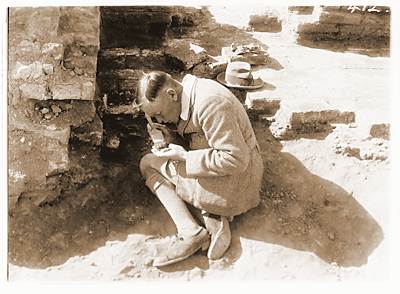 Leonard Woolley (1880-1960) got his first experiences as a field archaeologist in 1906, when Arthur Evans suggested that he oversee excavations at a Roman site in northern England. After that he worked on excavations in Nubia (1907-1911) and with T. E. Lawrence (Lawrence of Arabia) as his assistant at the Hittite city of Carchemish (1912-1914). The dig at Carchemish was also cover for undercover work for British Naval Intelligence. When WW I broke out, Woolley and Lawrence were posted to Cairo and Alexandria for naval espionage. Woolley was on a ship which was captured by the Turks, and Woolley was kept as a prisoner-of-war for two years. At the end of the War, Woolley was released, and returned to Carchemish, and then Tel el-Amarna in Egypt.
Leonard Woolley (1880-1960) got his first experiences as a field archaeologist in 1906, when Arthur Evans suggested that he oversee excavations at a Roman site in northern England. After that he worked on excavations in Nubia (1907-1911) and with T. E. Lawrence (Lawrence of Arabia) as his assistant at the Hittite city of Carchemish (1912-1914). The dig at Carchemish was also cover for undercover work for British Naval Intelligence. When WW I broke out, Woolley and Lawrence were posted to Cairo and Alexandria for naval espionage. Woolley was on a ship which was captured by the Turks, and Woolley was kept as a prisoner-of-war for two years. At the end of the War, Woolley was released, and returned to Carchemish, and then Tel el-Amarna in Egypt.
In 1922 Woolley and his wife Katherine, who was also an archaeologist, led an expedition for the British Museum and the University of Pennsylvania, to Ur of the Chaldees
 In 1927 the Woolleys excavated a Sumerian cemetery (the "Royal Cemetery of Ur") dating from c. 2600 BC. Amongst their finds were superb artistic treasures, such as a delicate golden head-dress for a noble lady, and a harp inlaid with lapis-lazuli and ivory.
In 1927 the Woolleys excavated a Sumerian cemetery (the "Royal Cemetery of Ur") dating from c. 2600 BC. Amongst their finds were superb artistic treasures, such as a delicate golden head-dress for a noble lady, and a harp inlaid with lapis-lazuli and ivory.
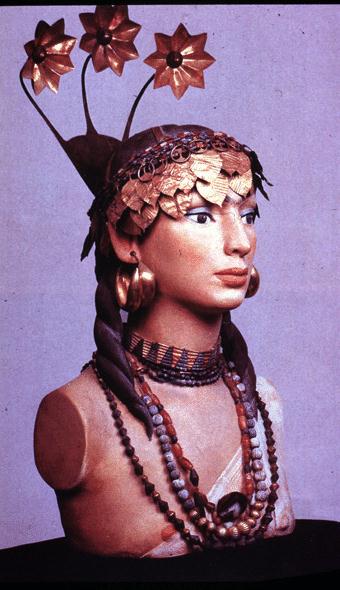 These treasures were eventually housed in the Iraq National Museum in Baghdad. The Museum was ransacked by Iraqi looters during the wars in Iraq, and the previous regime probably sold some of them secretly to raise funds for their own building and military projects. Many of the archaeological treasures are now missing, or have been found damaged.
These treasures were eventually housed in the Iraq National Museum in Baghdad. The Museum was ransacked by Iraqi looters during the wars in Iraq, and the previous regime probably sold some of them secretly to raise funds for their own building and military projects. Many of the archaeological treasures are now missing, or have been found damaged.
In 1929 Woolley published his evidence for a devastating flood at Ur, which he proposed supported the idea of Noah's flood, at least on a local scale.
"400 miles long and 100 miles wide; but for the occupants of the valley that was the whole world.", Ur of the Chaldees, 1929, p.31
In 1936 Woolley decided to investigate the relations between the civilizations of the Aegean (Minoans and Mycenaeans) and Mesopotamia (Sumeria, Babylon, Assyria), and started to work at Tel Atchana. His work was interrupted by WW II, when he served in the army, but afterwards he was able to return to Tel Atchana.
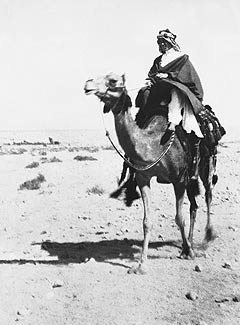 T. E. Lawrence, "Lawrence of Arabia" (1888-1935) was a British Army officer, diplomat, and archaeologist.
During WW I he helped the Arab Revolt (1916-1918) and the Sinai and Palestine Campaign (1915-1918) against the Ottoman Empire.
T. E. Lawrence, "Lawrence of Arabia" (1888-1935) was a British Army officer, diplomat, and archaeologist.
During WW I he helped the Arab Revolt (1916-1918) and the Sinai and Palestine Campaign (1915-1918) against the Ottoman Empire.
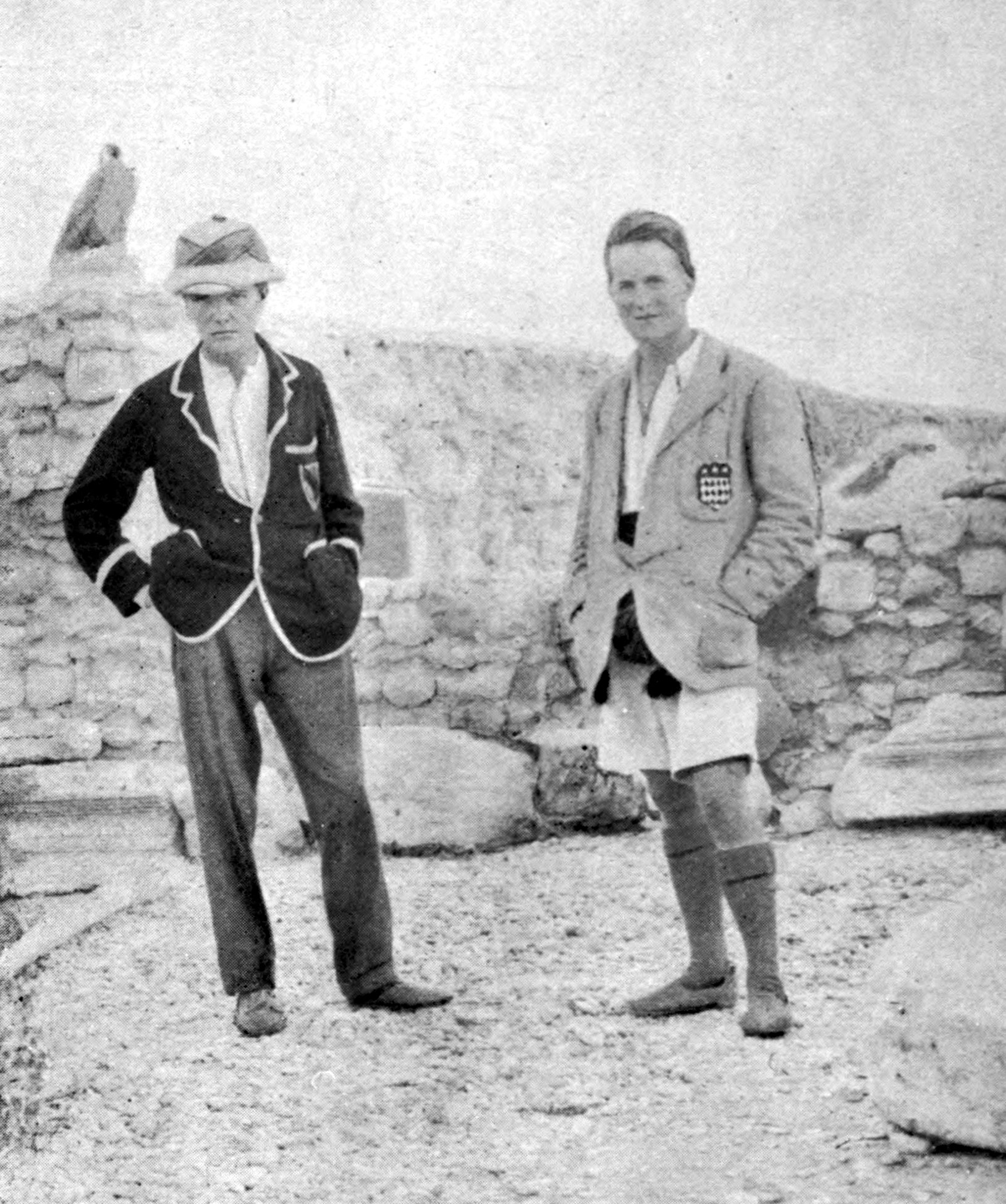 After graduating from Oxford University, Lawrence worked as an archaeologist for the British Museum, and during 1910-1914 was sent to a dig at Carchemish in Syria. One of his dig directors at Carchemish was Leonard Woolley. He also met Gertrude Bell at Carchemish, and in worked with Flinders Petrie in Egypt. When WW I broke out, Lawrence and Woolley surveyed the Negev Desert (between Palestine and Egypt) for the British military. Lawrence joined the British Army, and was sent on Intelligence missions throughout Egypt, Arabia, and Mesopotamia. After WW I he served with the British Foreign Office until 1926, when he retired from public life and re-enlisted to work as an ordinary aircraftman with the RAF (Royal Air Force).
After graduating from Oxford University, Lawrence worked as an archaeologist for the British Museum, and during 1910-1914 was sent to a dig at Carchemish in Syria. One of his dig directors at Carchemish was Leonard Woolley. He also met Gertrude Bell at Carchemish, and in worked with Flinders Petrie in Egypt. When WW I broke out, Lawrence and Woolley surveyed the Negev Desert (between Palestine and Egypt) for the British military. Lawrence joined the British Army, and was sent on Intelligence missions throughout Egypt, Arabia, and Mesopotamia. After WW I he served with the British Foreign Office until 1926, when he retired from public life and re-enlisted to work as an ordinary aircraftman with the RAF (Royal Air Force).
Eleazar Sukenik (1889-1953) was born in Belostok, which was then part of the Russian Empire, but is now part of Poland. He immigrated to Palestine in 1912, where he worked as a school teacher and tour guide while studying archaeology in Jerusalem.
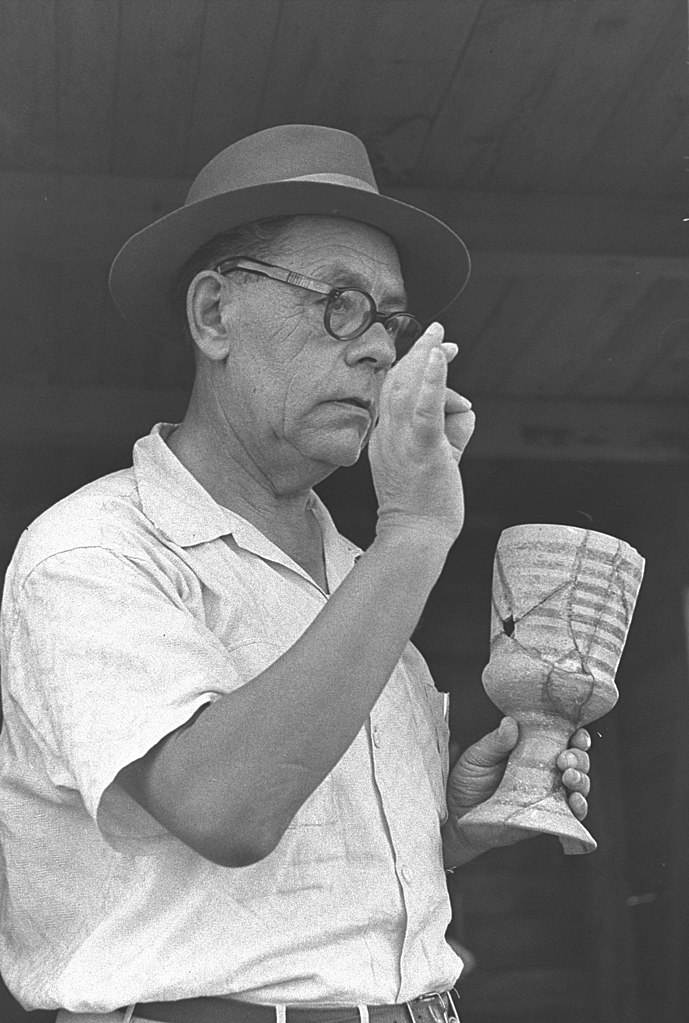 During WW I he served in the British army, but returned to archaeology after the War. His children all changed their names to Yadin in keeping with the custom of Israelis to choose new names to show allegiance to the new State of Israel. One of his sons was Yigael Yadin, who also became an archaeologist. Sukenik became a Professor at the Hebrew University of Jerusalem, and helped to establish the Department of Archaeology at that University. He excavated sites in Jerusalem and Samaria, including the "Third Wall" and the ossuary tombs of Jerusalem. He was one of the first scholars to work on the Dead Sea Scrolls, and showed their relationship to the near-by Qumran Community of Essenes.
During WW I he served in the British army, but returned to archaeology after the War. His children all changed their names to Yadin in keeping with the custom of Israelis to choose new names to show allegiance to the new State of Israel. One of his sons was Yigael Yadin, who also became an archaeologist. Sukenik became a Professor at the Hebrew University of Jerusalem, and helped to establish the Department of Archaeology at that University. He excavated sites in Jerusalem and Samaria, including the "Third Wall" and the ossuary tombs of Jerusalem. He was one of the first scholars to work on the Dead Sea Scrolls, and showed their relationship to the near-by Qumran Community of Essenes.
William Foxwell Albright (1891-1971)
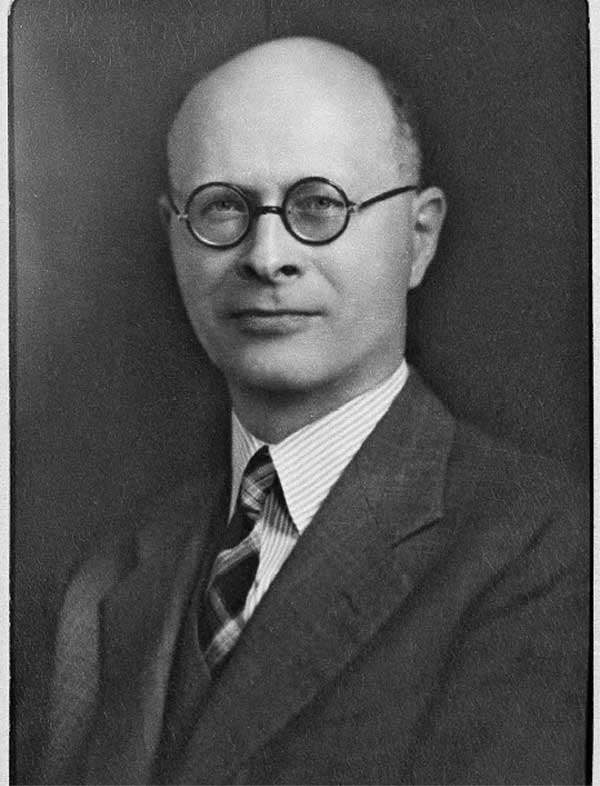 was an American archaeologist and linguist who specialized in Semitic languages and Biblical history. He participated in excavations at Gibeah (Saul's stronghold), Bethel, Petra (in Jordan), Beth-Zur, Tell Beit Mirsim, and Kirjath-Sepher, but is probably most famous for his work on the Dead Sea Scrolls. From an initially skeptical view-point, Albright came to the conclusion that archaeology confirmed the historicity of the major biblical figures and events. He is generally regarded as the founder of Biblical Archaeology. He developed the methods of ceramic chronology which Flinders Petrie had introduced, and produced dating methods for Near Eastern pottery which became a standard for the dating of Israelite sites.
was an American archaeologist and linguist who specialized in Semitic languages and Biblical history. He participated in excavations at Gibeah (Saul's stronghold), Bethel, Petra (in Jordan), Beth-Zur, Tell Beit Mirsim, and Kirjath-Sepher, but is probably most famous for his work on the Dead Sea Scrolls. From an initially skeptical view-point, Albright came to the conclusion that archaeology confirmed the historicity of the major biblical figures and events. He is generally regarded as the founder of Biblical Archaeology. He developed the methods of ceramic chronology which Flinders Petrie had introduced, and produced dating methods for Near Eastern pottery which became a standard for the dating of Israelite sites.
In 1927 he joined Johns Hopkins University, and became Professor of Semitic Studies in 1930 - a position he held until his retirement in 1958.
During 1922-1936 he was Director of the American School of Oriental Research in Jerusalem (ASOR) - now known as the Albright Institute of Archaeological Research.
In 1948 Albright worked on the authentication of the Dead Sea Scrolls.
He was a prolific author, and wrote one of the first books on Biblical archaeology "The Archaeology of Palestine" (Pelican, 1949). His students include the Biblical scholars Frank Moore Cross, Raymond E. Brown, John Bright, and many of the younger Israeli archaeologists.
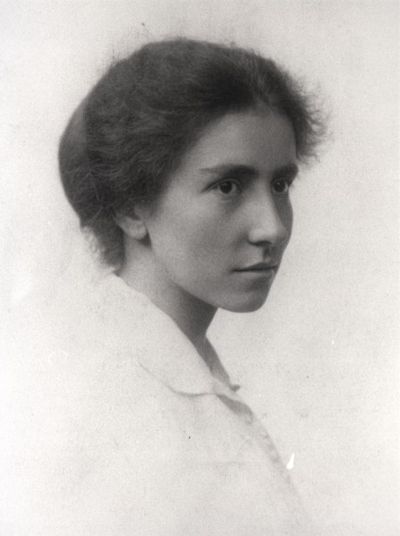 Dorothy Garrod (1892-1968) was an English archaeologist with an interest in the Palaeolithic Age. Her first studies were on Neanderthals in Europe, and Palaeolithic remains in Britain.
Dorothy Garrod (1892-1968) was an English archaeologist with an interest in the Palaeolithic Age. Her first studies were on Neanderthals in Europe, and Palaeolithic remains in Britain.

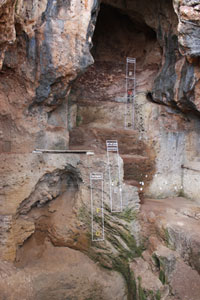 In 1929 she was appointed to lead excavations in the caves of Wadi el-Mughara at Mount Carmel in Palestine, as part of a joint project by the American School of Prehistoric Research and the British School of Archaeology in Jerusalem. She uncovered a long sequence of occupation levels in the caves, dating to the Palaeolithic Ages, including the Natufian culture at Wadi an-Natuf. For her excavations, Garrod employed Arab women from the local villages.
In 1929 she was appointed to lead excavations in the caves of Wadi el-Mughara at Mount Carmel in Palestine, as part of a joint project by the American School of Prehistoric Research and the British School of Archaeology in Jerusalem. She uncovered a long sequence of occupation levels in the caves, dating to the Palaeolithic Ages, including the Natufian culture at Wadi an-Natuf. For her excavations, Garrod employed Arab women from the local villages.
In 1939 she was appointed as a Professor of Archaeology at the University of Cambridge - She was the first woman to hold a Chair at either Oxford or Cambridge University.
During WW II she served in the Women's Auxiliary Air Force (WAAF), after the War she returned to Cambridge, to continue as Chair and to reorganize the teaching of archaeology and prehistory.
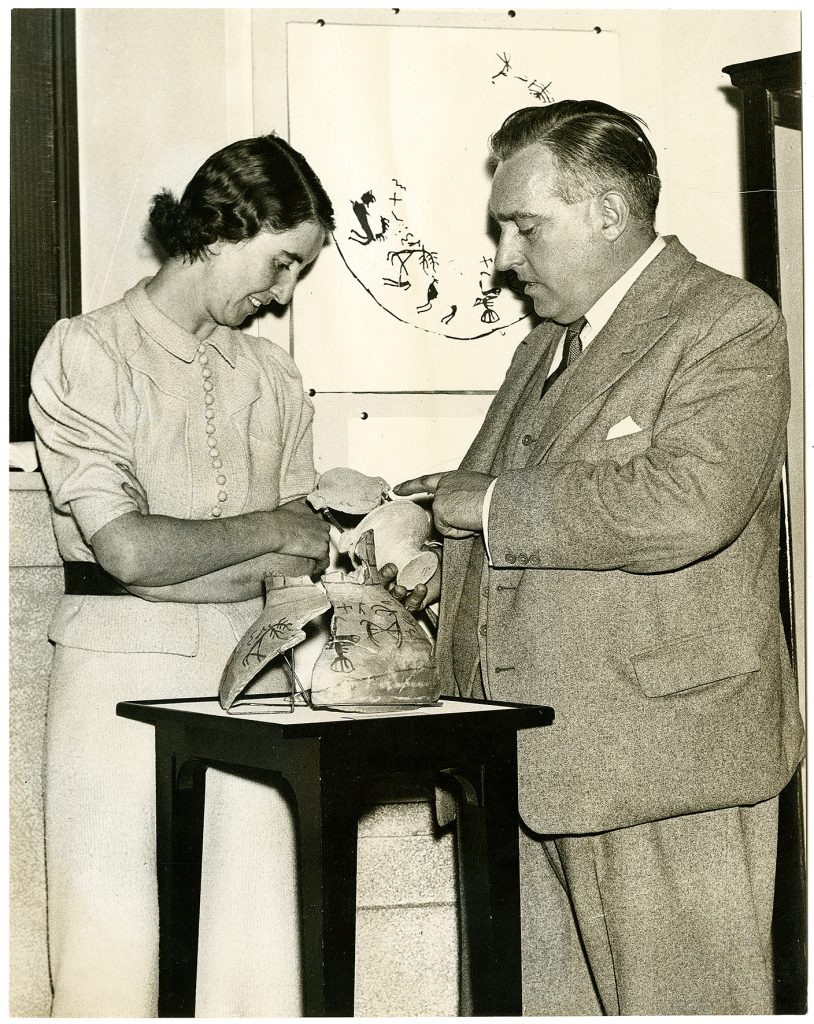 James Leslie Starkey (1895-1938) was a British archaeologist who led the first excavation of Lachish from 1932 until he was murdered in 1938. He was robbed and killed in the desert near Hebron, but the circumstances of his murder are clouded. The British authorities believed that he was killed by a group of Arab rebels, but others suspected local owners of the site at Lachish who were disputing the territory with the government.
James Leslie Starkey (1895-1938) was a British archaeologist who led the first excavation of Lachish from 1932 until he was murdered in 1938. He was robbed and killed in the desert near Hebron, but the circumstances of his murder are clouded. The British authorities believed that he was killed by a group of Arab rebels, but others suspected local owners of the site at Lachish who were disputing the territory with the government.
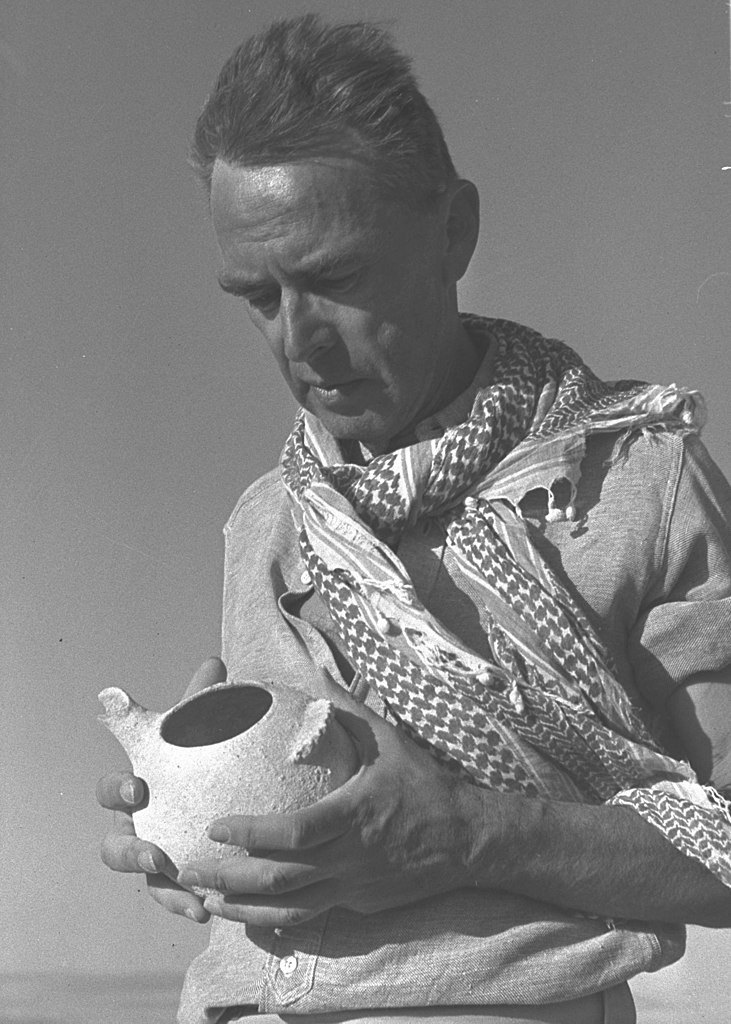 Nelson Glueck (1900-1971) was an American rabbi who was one of the pioneering archaeologists of the Holy Land. He discovered more than a thousand archaeological sites in the Holy Land. He grew up in Cincinnati, and was ordained as a reform rabbi in 1923. In 1928 he joined the faculty of the Hebrew Union College, and in 1947 he was made President of the College. His books helped to popularize Biblical archaeology
Nelson Glueck (1900-1971) was an American rabbi who was one of the pioneering archaeologists of the Holy Land. He discovered more than a thousand archaeological sites in the Holy Land. He grew up in Cincinnati, and was ordained as a reform rabbi in 1923. In 1928 he joined the faculty of the Hebrew Union College, and in 1947 he was made President of the College. His books helped to popularize Biblical archaeology
 Olga Tufnell (1905-1985) was a British archaeologist who had no formal training in archaeology. Her mother was a friend of Hilda Petrie (Flinders Petrie's wife), and Olga helped them with an exhibition of their finds. After that, she became a secretary for the British School of Archaeology in Egypt, and not only worked as a secretary and fund-raiser, but began to draw and repair pottery from the digs. In 1927 Flinders Petrie asked her to join his team as an archaeologist. She was sent to work with James Leslie Starkey in Palestine, and rose to the rank of supervisor. Her work was so good the Petrie allowed her to publish her own findings.
Olga Tufnell (1905-1985) was a British archaeologist who had no formal training in archaeology. Her mother was a friend of Hilda Petrie (Flinders Petrie's wife), and Olga helped them with an exhibition of their finds. After that, she became a secretary for the British School of Archaeology in Egypt, and not only worked as a secretary and fund-raiser, but began to draw and repair pottery from the digs. In 1927 Flinders Petrie asked her to join his team as an archaeologist. She was sent to work with James Leslie Starkey in Palestine, and rose to the rank of supervisor. Her work was so good the Petrie allowed her to publish her own findings.
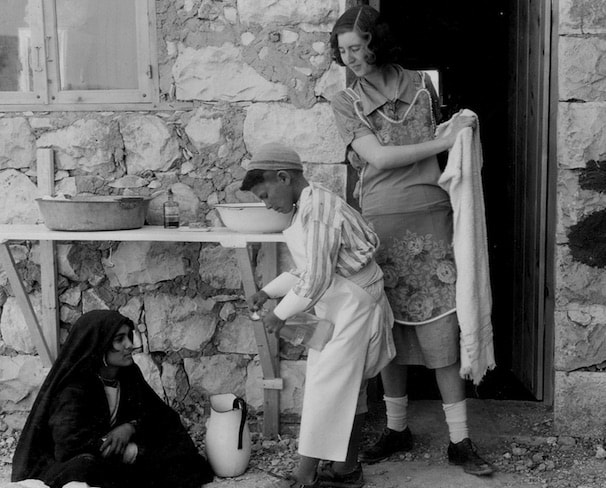 Not only did she spend the day at the excavation, but in the evenings she ran a health clinic for the Arab workers and other local families
Not only did she spend the day at the excavation, but in the evenings she ran a health clinic for the Arab workers and other local families
In 1932 Starkey started his own dig at Lachish, and Olga joined him and worked there for the next six years. During this time they found the Lachish Letters which recorded the last days of the city of Lachish under siege by the Assyrians. Starkey was murdered in 1938 and the excavation team broke up. Olga took on the work of writing up the final report of the dig, and was given rooms in the Institute of Archaeology at University College in London. Her work was halted almost immediately when WW II broke out in 1939; because of her experience she was sent to help at the BBC's Arabic broadcasts. After the War she returned to the work of writing the report on Lachish.
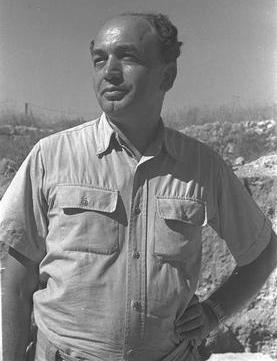 Nahman Avigad (b. 1905-1992) was an Israeli archaeologist who was born in what is now Ukraine, and moved to Palestine in 1926.
Nahman Avigad (b. 1905-1992) was an Israeli archaeologist who was born in what is now Ukraine, and moved to Palestine in 1926.
In 1949 he joined the faculty of the Hebrew University, and taught there until he retired in 1974.
In 1953 he became dig Director at Beit She'arim.
In 1969 he was asked to start excavations in the Jewish Quarter of the Old City of Jerusalem, where he discovered the Burnt House (dating to the time when the Romans burned Jerusalem in AD 70) and the Broad Wall (part of King Hezekiah's defence of the city against the Babylonians).
He worked on the tombs in the Kidron valley of Jerusalem, the mountain fortress of Masada, the Dead Sea Scrolls, and the caves in the wilderness of Judah. He was an expert of epigraphy (the study of writing and how it changes over time)
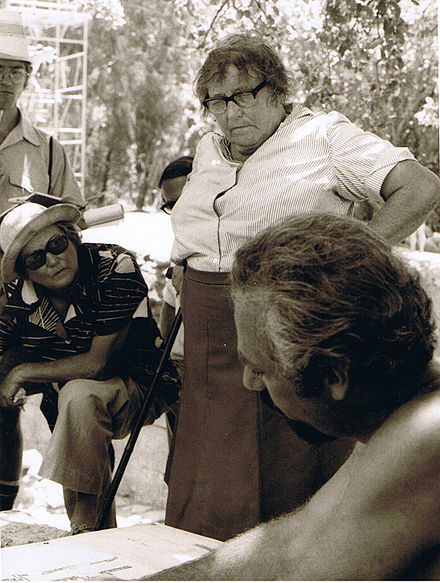 Kathleen Kenyon (1906-1978) was a British archaeologist who led excavations at Jericho (Tell es-Sultan), and developed ways of dating by the chronology of pottery remains.
Kathleen Kenyon (1906-1978) was a British archaeologist who led excavations at Jericho (Tell es-Sultan), and developed ways of dating by the chronology of pottery remains.
Kathleen Kenyon's father was a biblical scholar and the Director of the British Museum. As a child, Kenyon lived in a house next to the British Museum, and had decided at an early age to become an archaeologist. In 1929 she graduated from Oxford University, and in 1930 she joined the team of archaeologists led by Mortimer Wheeler at the excavation of the Romano-British settlement of Verulamium (St. Albans) in England. Kenyon worked at Verulamium for the next five seasons, eventually becoming the dig director for part of the excavation. During this time she learned the system of stratigraphic excavation pioneered by Mortimer Wheeler.
During 1931-1934 she also worked on an excavation at Samaria, where she gained experience in cutting a trench to reveal the stratigraphic sequence of the site.
WWII interrupted her archaeological career, and she became a Divisional Commander of the Red Cross in London.
After WWII Kenyon worked to reopen the British School of Archaeology in Jerusalem, and in 1951 she was able to move to Jericho where she started to dig the mound of the ancient city at Tell es-Sultan. During 1951-1958 she excavated Tell es-Sultan (Jericho), digging a stratigraphic trench down to bedrock, and revealing a history of the site going back to Neolithic times. I have walked along the bottom of the trench into the center of the site - it is enormous, with trench walls towering far above, and a Neolithic stone tower jutting into the trench.
Jericho is generally acknowledged to be the oldest permanently-occupied city in the world (from Pre-Pottery Neolithic up to modern day)
Her work at Jericho enabled Kenyon to develop methods of dating the layers of a site by reference to the styles of pottery found there - this method remains one of the most important ways of dating the layers of a dig.
After Jericho, Kenyon excavated in the "City of David" region of Jerusalem (near the Temple Mount) during 1961-1967
Artefacts from her excavations are held by several museums in Britain and the USA. Her collected papers and books are housed at Baylor University in Texas.
Benjamin Mazar (1906-1995) was an Israeli archaeologist and historian who taught many of today's archaeologists and Biblical historians. He was born in Poland and educated in Germany, then emigrated to Palestine in 1929.
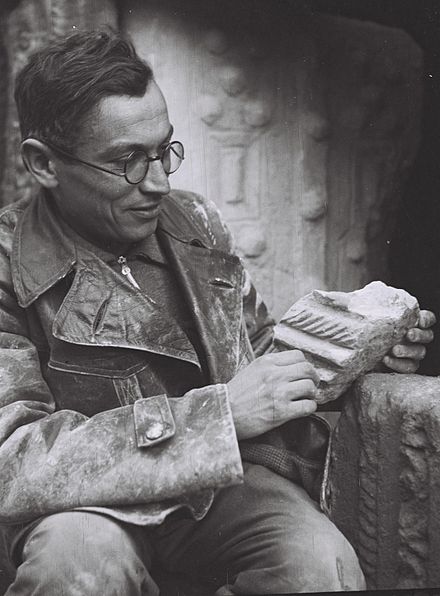 He was trained as an Assyriologist and was an expert on Biblical history; he developed the field of the historical geography of Israel. He became chairman of the Israel Exploration Society, and founded the Archaeological Council of Israel, to be responsible for all archaeological surveys and excavations in Israel, and served as chairman of that Council.
He was trained as an Assyriologist and was an expert on Biblical history; he developed the field of the historical geography of Israel. He became chairman of the Israel Exploration Society, and founded the Archaeological Council of Israel, to be responsible for all archaeological surveys and excavations in Israel, and served as chairman of that Council.
In 1936 he led the first Jewish archaeological excavation, at Beit Shearim.
In 1943 he joined the faculty of the Hebrew University of Jerusalem, and was Professor of Biblical History and Archaeology there from 1951 to 1977. He became Rector of the University in 1952, and President in 1953-1961. He founded a new campus for the Hebrew University of Jerusalem, and Hadassah Medical School and Hospital.
In 1948 he was granted the first archaeological permit issued by the new State of Israel, for Tel Qasile (a Philistine site near modern Tel Aviv). He also excavated at En Gedi near the Dead Sea.
During the period 1968-1978 he directed excavations by the side of the Temple Mount in Jerusalem.
Eilat Mazar is his granddaughter, and Amihai Mazar his nephew.
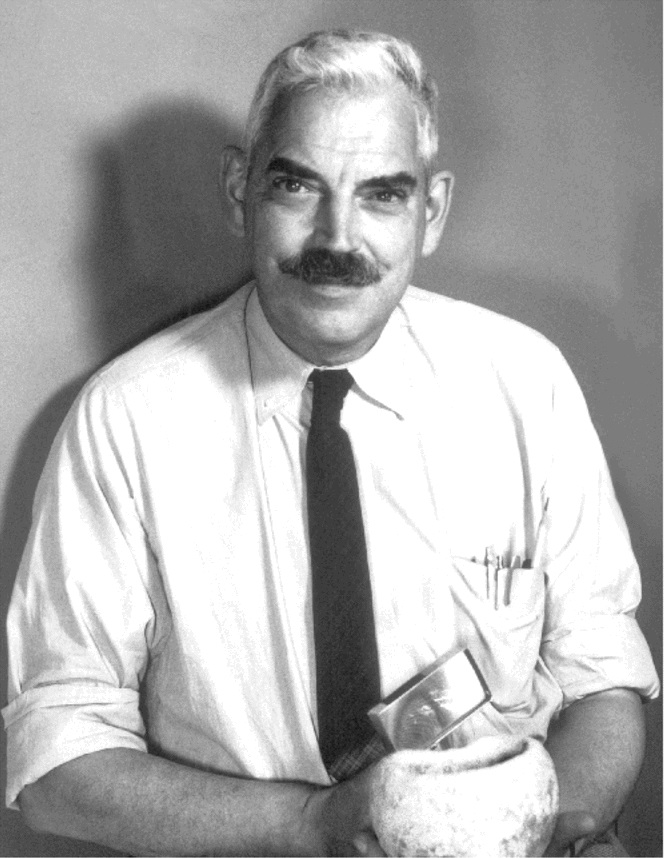 Robert Braidwood (1907-2003) was an American archaeologist and anthropologist. In 1933 he graduated with a Master's in architecture, and then joined James Breasted of the University of Chicago's Oriental Institute, in an expedition to the Amuq Plain in Turkey.
Robert Braidwood (1907-2003) was an American archaeologist and anthropologist. In 1933 he graduated with a Master's in architecture, and then joined James Breasted of the University of Chicago's Oriental Institute, in an expedition to the Amuq Plain in Turkey.
In 1937 he married a fellow-student, Linda, who also became an archaeologist and worked together with him on the digs.
During WW II he worked for the Army Air Corps.
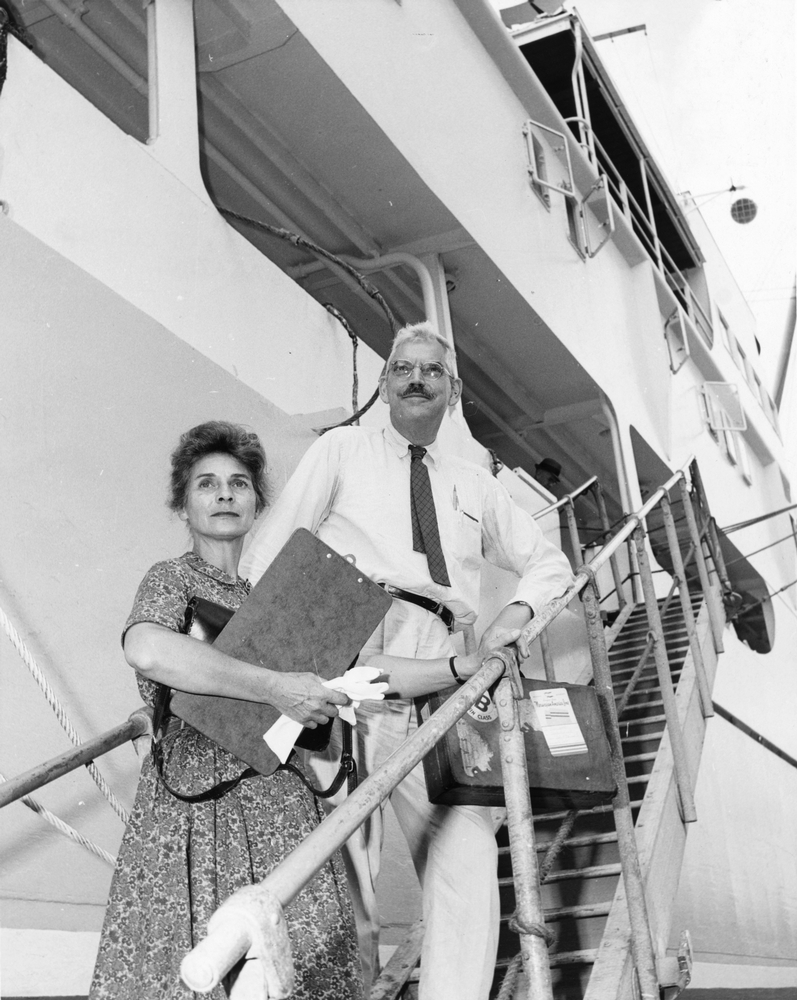 In 1943 Braidwood was awarded a Ph.D. and was immediately appointed as a professor by the Oriental Institute and the University of Chicago. He remained with them until he retired.
In 1943 Braidwood was awarded a Ph.D. and was immediately appointed as a professor by the Oriental Institute and the University of Chicago. He remained with them until he retired.
The expedition to the Amuq Plain was one of the first archaeological surveys to use scientific methods; all artefacts were mapped, recorded, and dated. Braidwood had learned about the technique of carbon dating from Willard Libby, and was one of the first to adopt this for dating organic materials.
In 1947 Braidwood organized an expedition to Iraq, to study the Neolithic settlement at Jarmo. He assembled a team of archaeologists, biologists, and geologists for a thorough study of the site and its origin. However, the 1958 revolution in Iraq made things so dangerous that they had to leave. The Braidwoods moved on to study other sites in Iran, and then in Turkey. At the site of Çayönü in southern Turkey they were able to study the shift of a society from hunter-gatherer to agriculture, and found evidence for the domestication of animals such as pigs. The Braidwoods continued to work at Çayönü until their last season in 1989.
Both Braidwoods died of pneumonia within a few hours of each other in 2003 - he was 95, and she 93.
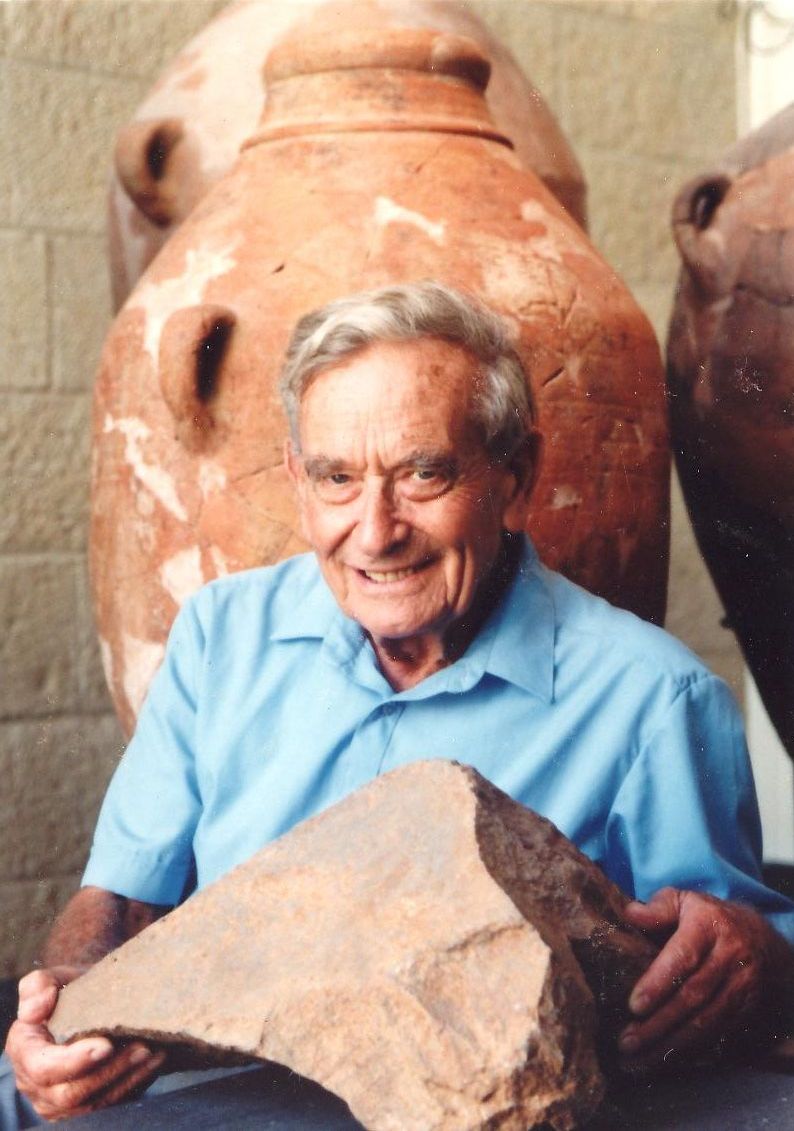 Avraham Biran (1909-2008) grew up in the Holy Land. As a schoolboy he was taken on hikes to ancient sites and archaeological digs - this started his love for archaeology. In 1930 he traveled to the USA to study archaeology, and studied under William Albright at Johns Hopkins University from 1931 to 1935, when he was awarded a doctorate. In 1935 he returned to Jerusalem, and took part in digs for the American Schools of Oriental Research.
In 1938 he started an archaeological survey of the Beth Shean valley.
Avraham Biran (1909-2008) grew up in the Holy Land. As a schoolboy he was taken on hikes to ancient sites and archaeological digs - this started his love for archaeology. In 1930 he traveled to the USA to study archaeology, and studied under William Albright at Johns Hopkins University from 1931 to 1935, when he was awarded a doctorate. In 1935 he returned to Jerusalem, and took part in digs for the American Schools of Oriental Research.
In 1938 he started an archaeological survey of the Beth Shean valley.
 In 1966 Biran started to excavate at Tel Dan in northern Israel, and continued to work there for 30 years. His most famous discovery was an inscription dating to ca. 800 BC which mentions a king "from the House of David" - this confirms the existence of a Davidic dynasty in Iron Age Israel, and is the first mention of David outside the Bible.
In 1966 Biran started to excavate at Tel Dan in northern Israel, and continued to work there for 30 years. His most famous discovery was an inscription dating to ca. 800 BC which mentions a king "from the House of David" - this confirms the existence of a Davidic dynasty in Iron Age Israel, and is the first mention of David outside the Bible.
He was head of the Hebrew Union College in Jerusalem, and helped to start the Israeli Museum and the Shrine of the Book (the museum in Jerusalem specially built for the Dead Sea Scrolls)
Besides his career as an archaeologist, Biran also became a diplomat and politician. He was a member of the City Council of Jerusalem shortly before the Declaration of Israel's Independence in 1948. He then served as assistant to the cabinet secretary and assistant military governor of Jerusalem. Then he served on the committee negotiating the cease-fire agreement with the Kingdom of Jordan. In 1955 he was appointed as consul-general of Israel in Los Angeles CA.
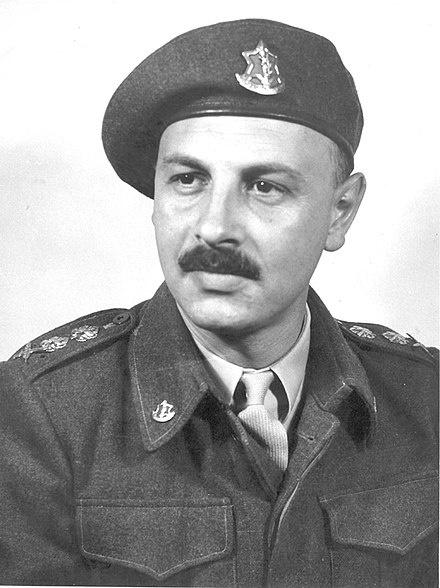 Yigael Yadin (1917-1984) was a soldier who became an archaeologist and Deputy Prime Minister of Israel
Yigael Yadin (1917-1984) was a soldier who became an archaeologist and Deputy Prime Minister of Israel
Yigael Yadin was born in Palestine (as it then was) during the Ottoman empire. His father was the archaeologist Eleazar Sukenik. Yadin (it was common for Israelis of that time to choose new Hebrew names for themselves) joined the Haganah (Israeli defense and sabotage forces before the State of Israel was established) when he was fifteen. When the state of Israel was about to be formed, and there was a need for defense forces, Yadin left University to enter active service,
 and was the Head of Operations for Israel during the 1948 Arab-Israel War. In 1949 he was appointed Chief of Staff of the Israeli Defense Forces and served until 1952.
and was the Head of Operations for Israel during the 1948 Arab-Israel War. In 1949 he was appointed Chief of Staff of the Israeli Defense Forces and served until 1952.
In 1952 Yadin left the military and began his archaeological studies. In 1956 he was awarded a doctorate for his work on translating some of the Dead Sea Scrolls. He went on to excavate at Masada, Hazor, Megiddo, Gezer, and the Qumran Caves.
In 1976 Yadin turned to politics, was elected to the Knesset in 1977 and became Deputy Prime Minister. In this capacity, he played a major part in relations with Egypt, the Camp David Accords, and the peace treaty between Israel and Egypt. He retired in 1981.
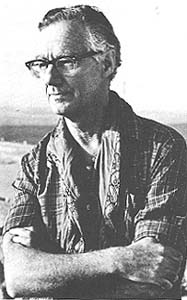 Yohanan Aharoni (1919-1976) was born in Germany, but immigrated to Palestine in 1933.
Yohanan Aharoni (1919-1976) was born in Germany, but immigrated to Palestine in 1933.
 He worked on many archaeological sites - Tel Be'er Sheva, Hazor, Lachish, Ramat Rachel, Arad, and the caves by the Dead Sea; he also studied the ancient roads of the Negev desert. He wrote popular books on Archaeology and the Bible.
He worked on many archaeological sites - Tel Be'er Sheva, Hazor, Lachish, Ramat Rachel, Arad, and the caves by the Dead Sea; he also studied the ancient roads of the Negev desert. He wrote popular books on Archaeology and the Bible.
He joined the faculty of the Hebrew University of Jerusalem in 1954, and became a professor there in 1966. In 1968 he moved to Tel Aviv University to become Chair of the Department of Near East Studies and Chair of the Institute of Archaeology.
 Trude Dothan (1922-2016) was born in Vienna, but her family moved to Palestine (as it then was) when she was one year old. She married a fellow archaeologist, Moshe Dothan, in 1951, and they worked together to investigate the Philistines and their culture. The Hebrew University of Jerusalem appointed her as a Chair in archaeology and the head of the Berman Center for Biblical Archaeology. The Dothans excavated several Philistine sites in Israel and also excavated at Deir el-Balah - an Egyptian outpost in Canaan which dated to the time of the Exodus.
Trude Dothan (1922-2016) was born in Vienna, but her family moved to Palestine (as it then was) when she was one year old. She married a fellow archaeologist, Moshe Dothan, in 1951, and they worked together to investigate the Philistines and their culture. The Hebrew University of Jerusalem appointed her as a Chair in archaeology and the head of the Berman Center for Biblical Archaeology. The Dothans excavated several Philistine sites in Israel and also excavated at Deir el-Balah - an Egyptian outpost in Canaan which dated to the time of the Exodus.
William G. Dever (b. 1933) is an American archaeologist from a Christian evangelical family. As an adult he rejected Christianity and converted to Reform Judaism. Then he rejected that, and now claims to be a secular humanist and a non-believer.
 After studying archaeology in the USA, including a doctorate from Harvard, Dever became director of excavations at Gezer and other sites in Israel, Jordan, and Cyprus. His views of Israelite religion are very controversial - based on the number of female "Asherah" statues found in Iron Age sites, he maintains that most of the 'ordinary Israelites' retained a 'folk-religion' with a fertility goddess whom he refers to as a 'wife' of God.
After studying archaeology in the USA, including a doctorate from Harvard, Dever became director of excavations at Gezer and other sites in Israel, Jordan, and Cyprus. His views of Israelite religion are very controversial - based on the number of female "Asherah" statues found in Iron Age sites, he maintains that most of the 'ordinary Israelites' retained a 'folk-religion' with a fertility goddess whom he refers to as a 'wife' of God.
He also claims that the Pentateuch and the Book of Joshua are largely fictional propaganda, and that truly historical material is only found in the Book of Judges and subsequent Books of the Old Testament.
His career and reputation have been clouded by a bitter feud which he carries on with Israel Finkelstein. An attempt was made to get the two men to debate their positions, but it degenerated into mere name-calling and insults and was closed down to avoid further embarrassment to the academic community.
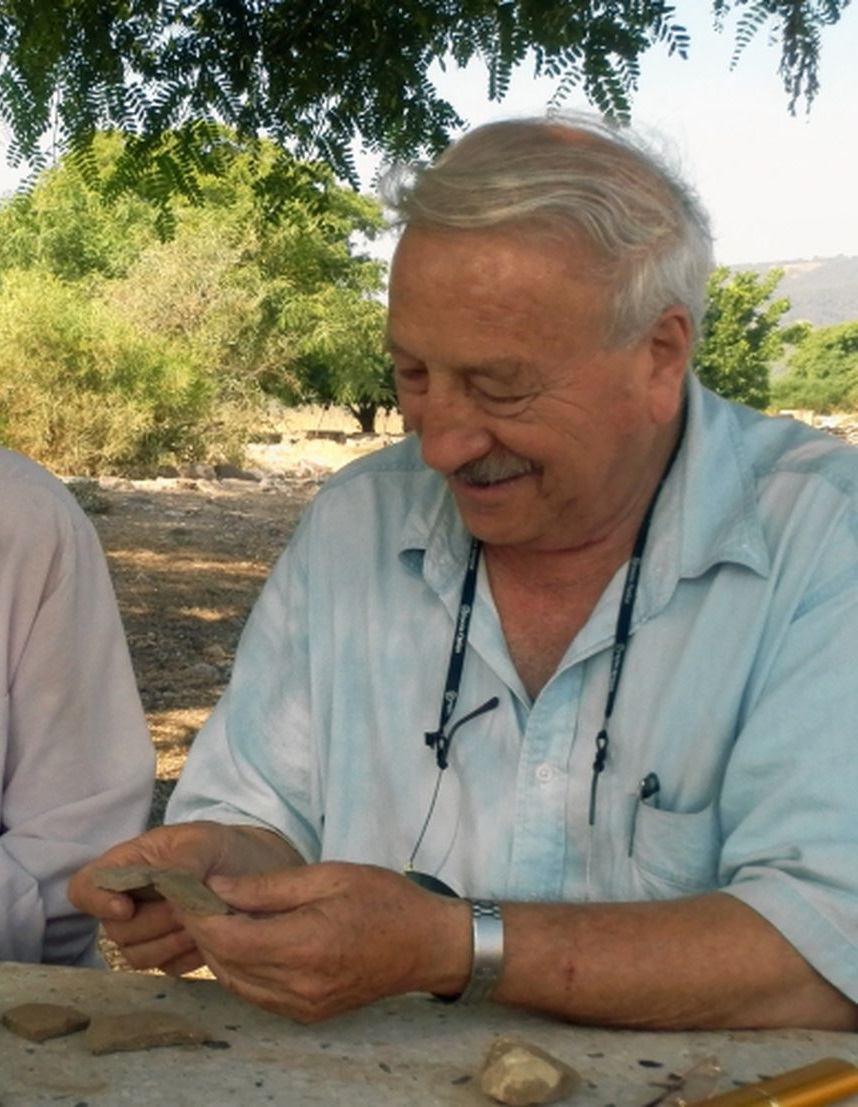 Amnon Ben-Tor (b.1935) is professor emeritus at the Institute of Archaeology, the Hebrew University, Jerusalem. He worked as an area supervisor at Hazor under the direction of Yigael Yadin during the 1950s and 1960s, and has been director of the excavations at Hazor since 1990. He has also worked at Masada and several other sites, including one on the island of Cyprus.
Amnon Ben-Tor (b.1935) is professor emeritus at the Institute of Archaeology, the Hebrew University, Jerusalem. He worked as an area supervisor at Hazor under the direction of Yigael Yadin during the 1950s and 1960s, and has been director of the excavations at Hazor since 1990. He has also worked at Masada and several other sites, including one on the island of Cyprus.
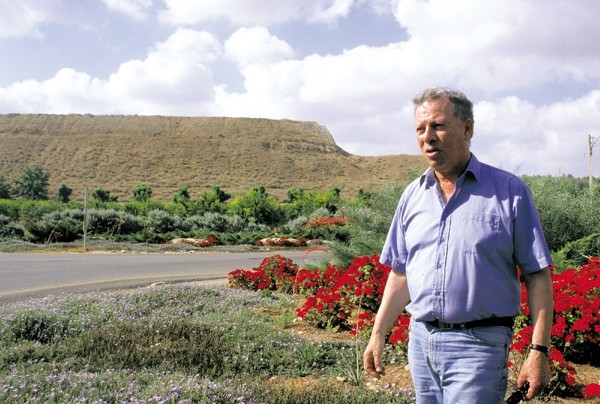 David Ussishkin (b.1935) is an Israeli archaeologist whose main interest is the Iron Age in Israel. His doctoral work was directed by Yigael Yadin. He earned his doctorate in 1966, then joined the University of Tel Aviv, where he taught until his retirement in 2004. He took part in many digs - at Megiddo, under the direction of Yigael Yadin, at Beersheba, and at Nahal Hever (1960-1961). During 1961-1962 he worked at Ein Gedi, under the direction of Benjamin Mazar, and supervised the excavation of the unique Chalcolithic Temple at the head of the wadi. During 1964-1965 he was field supervisor at Yigael Yadin's excavations of Masada, and in 1967-1968 he was co-director of excavations at Khirbet Kerak.
David Ussishkin (b.1935) is an Israeli archaeologist whose main interest is the Iron Age in Israel. His doctoral work was directed by Yigael Yadin. He earned his doctorate in 1966, then joined the University of Tel Aviv, where he taught until his retirement in 2004. He took part in many digs - at Megiddo, under the direction of Yigael Yadin, at Beersheba, and at Nahal Hever (1960-1961). During 1961-1962 he worked at Ein Gedi, under the direction of Benjamin Mazar, and supervised the excavation of the unique Chalcolithic Temple at the head of the wadi. During 1964-1965 he was field supervisor at Yigael Yadin's excavations of Masada, and in 1967-1968 he was co-director of excavations at Khirbet Kerak.
During 1968-1971 Ussushkin led a survey of the Silwan region of Jerusalem - downhill from the Temple Mount, at the side of the Kidron valley.
His next excavation was much larger, the site at Tel Lachish, from 1973 to 1994. Lachish had been occupied by Canaanites, then was conquered by the Hebrews and became part of the territory of Judah, then was besieged and destroyed in 701 BC by the Assyrian King Sennacherib during the reign of King Hezekiah of Judah.
It was at Lachish that Ussishkin introduced some new ideas into excavation. The first was the use of large black cloths to provide shade for the workers - these are sometimes called Josh cloths in memory of Joshua who prayed that the sun would stand still (Joshua 10:12-14). The second came from his time with the Israeli Defense Forces in the Yom Kippur War of 1973 - he saw how sandbags could be used to protect trenches, and introduced that as a way of protecting the balks of an archaeological excavation.
In 1984 Ussishkin explored Beitar, a small settlement that was the last refuge of Simon Bar Kochbar in his revolt against the Romans in 135 AD.
Another major project was Ussishkin's excavation at Jezreel during 1990-1996 which uncovered fortifications dating to the time of King Omri of Israel and his son King Ahab.
From 1992 until the present the University of Tel Aviv has conducted excavations at Megiddo - a great fortress town in northern Israel. The excavations have been led by Ussishkin and Israel Finkelstein, and are continuing to the present.
 Amihai Mazar (b.1942) is an Israeli archaeologist, presently a professor at the Hebrew University of Jerusalem. He was born into a family of archaeologists - his uncle was Benjamin Mazar, and one of his cousins was Eilat Mazar.
Amihai Mazar (b.1942) is an Israeli archaeologist, presently a professor at the Hebrew University of Jerusalem. He was born into a family of archaeologists - his uncle was Benjamin Mazar, and one of his cousins was Eilat Mazar.
Amihai Mazar excavated at Tel Qasile, Timnah, Beth Shearim, Tel Rehov, and also at a worship center known as the Bull Site (because a statue of a bull was discovered there). His textbook, "Archaeology of the Land of the Bible", is probably the most widely used textbook relating to Biblical archaeology.
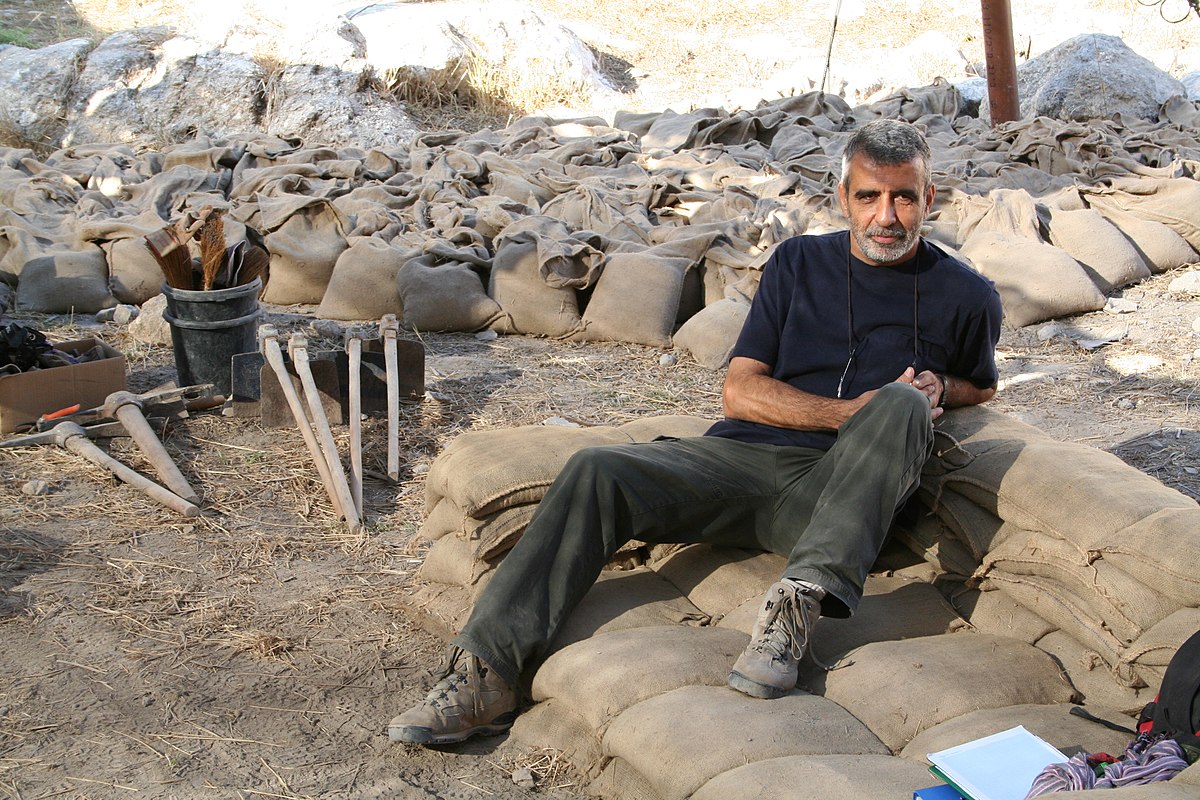 Israel Finkelstein (b. 1949) is an Israeli archaeologist who is currently Director of the excavations at Megiddo.
After serving in the Israel Defense Forces (1967-1970) he studied archaeology as a student of Yohanan Aharoni at Tel Aviv University, and in 1971 he joined Aharoni's dig at Tel Beer Sheva. From 1973 to 1978 he was part of the team excavating Tel Aphek. In 1976 he started directing surveys and excavations of his own - these included some sites in the Sinai and the Negev as well as near Tel Aviv and in the valley of Beer Sheva. From 1981 to 1984 he was Director of an excavation at Shiloh, and from 1981 to 1987 he directed a survey of Southern Samaria. After his doctorate in 1983 he joined a group led by Yigael Yadin at the Hebrew University.
Israel Finkelstein (b. 1949) is an Israeli archaeologist who is currently Director of the excavations at Megiddo.
After serving in the Israel Defense Forces (1967-1970) he studied archaeology as a student of Yohanan Aharoni at Tel Aviv University, and in 1971 he joined Aharoni's dig at Tel Beer Sheva. From 1973 to 1978 he was part of the team excavating Tel Aphek. In 1976 he started directing surveys and excavations of his own - these included some sites in the Sinai and the Negev as well as near Tel Aviv and in the valley of Beer Sheva. From 1981 to 1984 he was Director of an excavation at Shiloh, and from 1981 to 1987 he directed a survey of Southern Samaria. After his doctorate in 1983 he joined a group led by Yigael Yadin at the Hebrew University.
In 1994 he became co-director, with Daivd Ussishkin, of the excavations at Megiddo, where he has worked until the present day.
He incorporates as much science as possible into his studies, using radiocarbon dating, ancient DNA analysis, climate analysis, metallurgy, and archaeozoology (the remains of animals).
He is now a professor emeritus at Tel Aviv University.
He has written several textbooks and popular books about archaeology and the history of Israel.
Finkelstein proposed a re-dating of some of the periods of Biblical history, with a theory about the dating of the Exodus and the reigns of Saul, David, and Solomon which is referred to as the Low Chronology. This has been criticized by Amihai Mazar, Amnon Ben-Tor, and David Ussishkin, and led to a slanging match with William Dever.
 Eilat Mazar (1956-2021) was an Israeli archaeologist. She was the granddaughter of Benjamin Mazar, and the cousin of Amihai Majar. After obtaining a BA degree she joined an archaeological team investigating the Phoenician culture. After that she started to excavate in Jerusalem.
Eilat Mazar (1956-2021) was an Israeli archaeologist. She was the granddaughter of Benjamin Mazar, and the cousin of Amihai Majar. After obtaining a BA degree she joined an archaeological team investigating the Phoenician culture. After that she started to excavate in Jerusalem.
.
In 2005 she announced the discovery and excavation of the Large Stone Structure near the Temple Mount in Jerusalem. This may be the remains of a royal palace - perhaps that of King David. Further finds were some bullae (the impressions of seals pressed into clay to seal documents), one of which bore the name of Jehucal, son of Shelemiah, son of Shevi (mentioned in the Bible, Jer. 38:1), the other, found in 2008, bore the name of Gedaliah son of Pashur (also mentioned in Jeremiah 38:1).

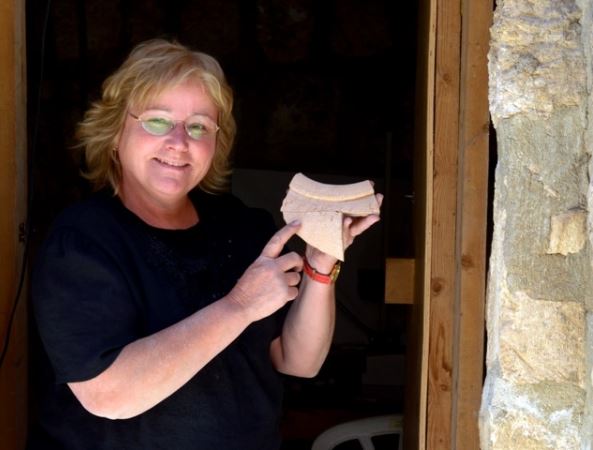 In 2007 she excavated a large wall in Jerusalem which is believed to date to the time of Nehemiah, and in 2010 she found further parts of the ancient city walls and a gateway which may date to the time of King Solomon.
In 2007 she excavated a large wall in Jerusalem which is believed to date to the time of Nehemiah, and in 2010 she found further parts of the ancient city walls and a gateway which may date to the time of King Solomon.
In 2012 she found the Ophel Inscription - a short inscription on a broken storage jar, which dates to the time of the United monarchy. Then in 2015 she found the Bulla of Hezekiah, a seal impression saying "Belonging to Hezekiah (son) of Ahaz king of Judah". In 2018 she discovered another bulla, which may have belonged to the prophet Isaiah (the inscription is damaged and incomplete).
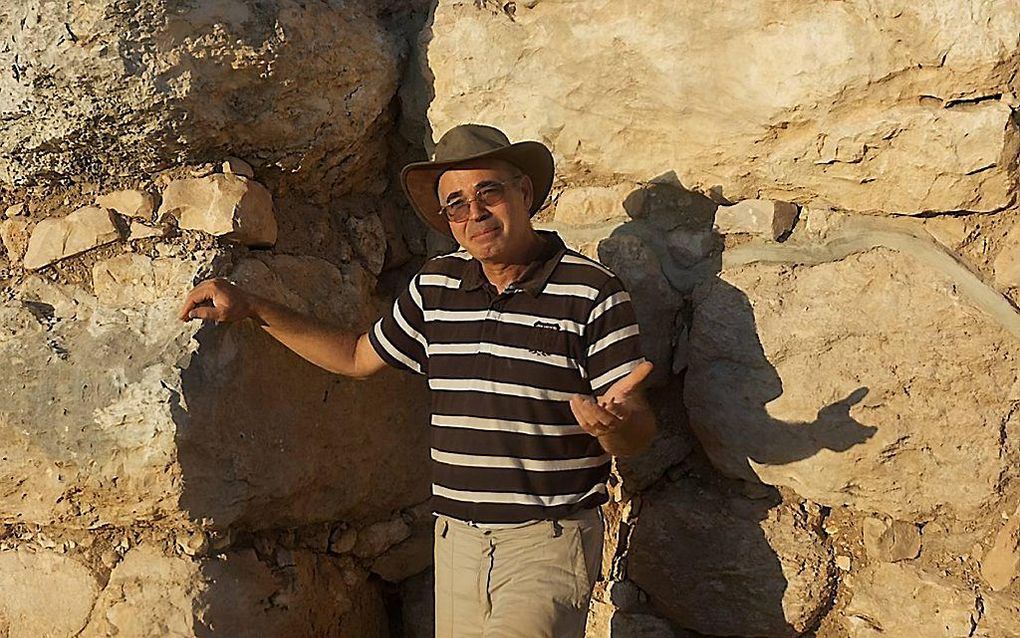 Yosef Garfinkel (b.1956) is an Israeli archaeologist who specializes in the archaeology of some of the earliest settlements in the Holy Land - the Yarmukian at Sha'ar HaGolan in northern Israel. He has excavated many Neolithic and Chalcolithic sites, and also a site at Khirbet Qeiyafa dating to the time of King David. He is currently digging at Tel Lachish.
Yosef Garfinkel (b.1956) is an Israeli archaeologist who specializes in the archaeology of some of the earliest settlements in the Holy Land - the Yarmukian at Sha'ar HaGolan in northern Israel. He has excavated many Neolithic and Chalcolithic sites, and also a site at Khirbet Qeiyafa dating to the time of King David. He is currently digging at Tel Lachish.
 Aren Maeir (b.1958) was born in the USA but immigrated to Israel in 1969. He served in the Israel Defense Forces, and then entered the Hebrew University of Jerusalem where he earned his doctorate in 1997. He joined the faculty of Bar-Ilan University in 1992. He participated in digs at Hazor, Yoqneam, Tel Qasile, Beth Shean, and Jerusalem. Since 1996 he has worked at Tel es-Safi - Gath of the Philistines.
Aren Maeir (b.1958) was born in the USA but immigrated to Israel in 1969. He served in the Israel Defense Forces, and then entered the Hebrew University of Jerusalem where he earned his doctorate in 1997. He joined the faculty of Bar-Ilan University in 1992. He participated in digs at Hazor, Yoqneam, Tel Qasile, Beth Shean, and Jerusalem. Since 1996 he has worked at Tel es-Safi - Gath of the Philistines.
Copyright © 2021 Shirley J. Rollinson, all Rights Reserved